
- •Study Skills Workshop
- •1.1 An Introduction to the Whole Numbers
- •1.2 Adding Whole Numbers
- •1.3 Subtracting Whole Numbers
- •1.4 Multiplying Whole Numbers
- •1.5 Dividing Whole Numbers
- •1.6 Problem Solving
- •1.7 Prime Factors and Exponents
- •1.8 The Least Common Multiple and the Greatest Common Factor
- •1.9 Order of Operations
- •THINK IT THROUGH Education Pays
- •2.1 An Introduction to the Integers
- •THINK IT THROUGH Credit Card Debt
- •2.2 Adding Integers
- •THINK IT THROUGH Cash Flow
- •2.3 Subtracting Integers
- •2.4 Multiplying Integers
- •2.5 Dividing Integers
- •2.6 Order of Operations and Estimation
- •Cumulative Review
- •3.1 An Introduction to Fractions
- •3.2 Multiplying Fractions
- •3.3 Dividing Fractions
- •3.4 Adding and Subtracting Fractions
- •THINK IT THROUGH Budgets
- •3.5 Multiplying and Dividing Mixed Numbers
- •3.6 Adding and Subtracting Mixed Numbers
- •THINK IT THROUGH
- •3.7 Order of Operations and Complex Fractions
- •Cumulative Review
- •4.1 An Introduction to Decimals
- •4.2 Adding and Subtracting Decimals
- •4.3 Multiplying Decimals
- •THINK IT THROUGH Overtime
- •4.4 Dividing Decimals
- •THINK IT THROUGH GPA
- •4.5 Fractions and Decimals
- •4.6 Square Roots
- •Cumulative Review
- •5.1 Ratios
- •5.2 Proportions
- •5.3 American Units of Measurement
- •5.4 Metric Units of Measurement
- •5.5 Converting between American and Metric Units
- •Cumulative Review
- •6.2 Solving Percent Problems Using Percent Equations and Proportions
- •6.3 Applications of Percent
- •6.4 Estimation with Percent
- •6.5 Interest
- •Cumulative Review
- •7.1 Reading Graphs and Tables
- •THINK IT THROUGH The Value of an Education
- •Cumulative Review
- •8.1 The Language of Algebra
- •8.2 Simplifying Algebraic Expressions
- •8.3 Solving Equations Using Properties of Equality
- •8.4 More about Solving Equations
- •8.5 Using Equations to Solve Application Problems
- •8.6 Multiplication Rules for Exponents
- •Cumulative Review
- •9.1 Basic Geometric Figures; Angles
- •9.2 Parallel and Perpendicular Lines
- •9.3 Triangles
- •9.4 The Pythagorean Theorem
- •9.5 Congruent Triangles and Similar Triangles
- •9.6 Quadrilaterals and Other Polygons
- •9.7 Perimeters and Areas of Polygons
- •THINK IT THROUGH Dorm Rooms
- •9.8 Circles
- •9.9 Volume
- •Cumulative Review
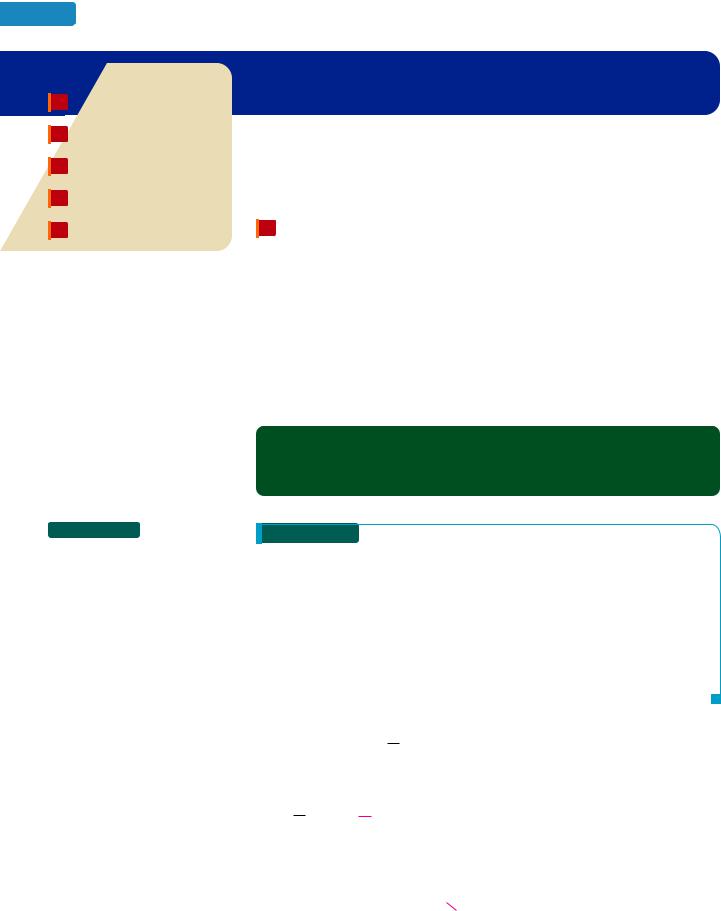
386 Chapter 4 Decimals
Objectives |
S E C T I O N 4.6 |
1Find the square root of a perfect square.
Square Roots
2Find the square root of fractions and decimals.
3Evaluate expressions that contain square roots.
4Evaluate formulas involving square roots.
We have discussed the relationships between addition and subtraction and between multiplication and division. In this section, we explore the relationship between raising a number to a power and finding a root. Decimals play an important role in this discussion.
5 Approximate square roots.
 Self Check 1
Self Check 1
Find the two square roots of 64.
Now Try Problem 21
1 Find the square root of a perfect square.
When we raise a number to the second power, we are squaring it, or finding its square.
The square of 6 is 36, because 62 36.
The square of 6 is 36, because ( 6)2 36.
The square root of a given number is a number whose square is the given number. For example, the square roots of 36 are 6 and 6, because either number, when squared, is 36.
Every positive number has two square roots. The number 0 has only one square root. In fact, it is its own square root, because 02 0.
Square Root
A number is a square root of a second number if the square of the first number equals the second number.
EXAMPLE 1 Find the two square roots of 49.
Strategy We will ask “What positive number and what negative number, when squared, is 49?”
WHY The square root of 49 is a number whose square is 49.
Solution
7 is a square root of 49 because 72 49
and
7 is a square root of 49 because ( 7)2 49. |
|
In Example 1, we saw that 49 has two square roots—one positive and one |
|
negative. The symbol 1 |
is called a radical symbol and is used to indicate a positive |
square1 root of a nonnegative number. When reading this symbol, we usually drop the word positive and1simply say square root. Since 7 is the positive square root of 49, we can write
49 7 49 represents the positive number whose square is 49.
Read as “the square root of 49 is 7.”
When a number, called the radicand, is written under a radical symbol, we have a
Radical symbol |
|
|
|
|
|
|
|
|
|
|
Radicand |
|
|
|
|
||
|
149 |
|
|
||
|
b |
|
|
|
|
|
|
|
|
||
Radical expression
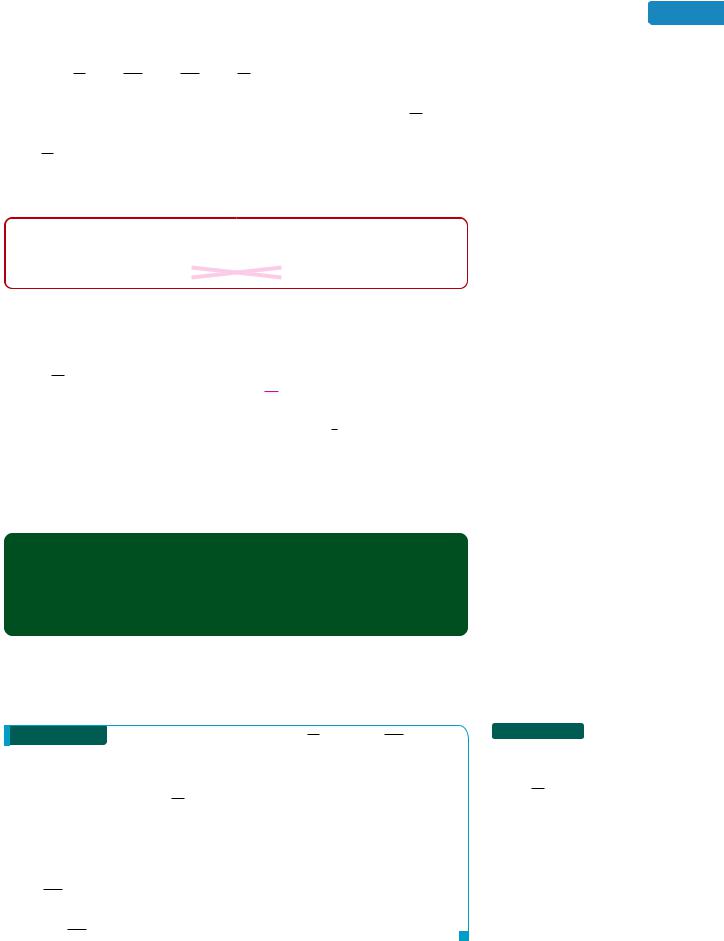
To1 evaluate (or simplify) a radical expression like those shown above,1we need to find the positive square root of the radicand. For example, if we evaluate 36 (read as “the square root of 36”), the result is
36 6
because 62 36.
Caution! Remember that the radical symbol asks you to find only the |
||||
positive square root of the radicand. It is incorrect, for example, to say that |
||||
|
1 |
|
is 6 and 6 |
|
|
36 |
|||
The symbol 1 |
|
is used to indicate the negative square root of a positive |
||
number.1It is the opposite of the positive square1 root. Since –6 is the negative square root of 36, we can write
36 6 Read as “the negative square root of 36 is 16” or “the opposite of the square root of 36 is 6.” 36 represents the negative number whose square is 36.
If the number under the radical symbol is 0, we have 0 0.
Numbers, such as 36 and 49, that are squares of whole numbers, are called perfect squares. To evaluate square root radical expressions, it is helpful to be able to identify perfect square radicands. You need to memorize the following list of perfect squares, shown in red.
Perfect Squares
0 |
02 |
16 42 |
64 |
82 |
144 122 |
1 |
12 |
25 52 |
81 |
92 |
169 132 |
4 |
22 |
36 62 |
100 |
102 |
196 142 |
9 |
32 |
49 72 |
121 |
112 |
225 152 |
A calculator is helpful in finding the square root of a perfect square that is larger
than 225. |
|
EXAMPLE 2 Evaluate each square root: a. |
181 b. 1100 |
WHY The radical symbol 1 indicates that the positive square root of the |
|
number written under it should be found. |
|
Solution |
|
a. 1 |
9 Ask: What positive number, when squared, is 81? |
Strategy In each case, we will determine what positive number, when squared, produces the radicand.
181 1 The answer is 9 because 92 81.
b. 100 is the opposite (or negative) of the square root of 100. Since 100 10, we have
100 10
4.6 Square Roots |
387 |
 Self1 Check 2
Self1 Check 2
Evaluate1 each square root: a. 144
b. 81
Now Try Problems 25 and 29
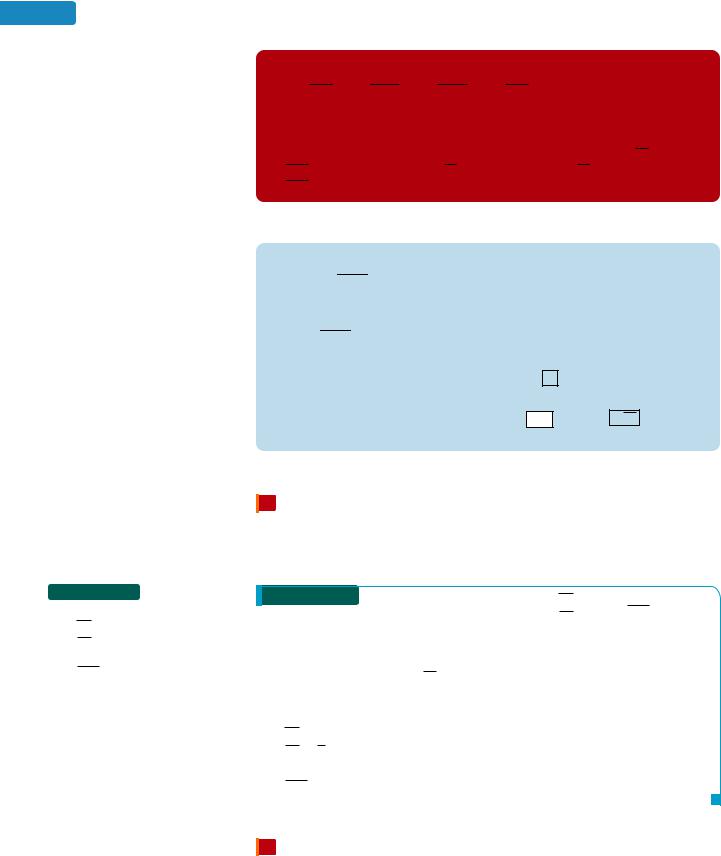
388 |
Chapter 4 Decimals |
Caution! Radical expressions such as |
1 81 |
||
1 36 |
1 100 |
1 144 |
|
do1 not represent real numbers,1because there are no real1 numbers1that when squared give a negative number.
Be careful to note the difference between expressions such as 36 and36. We have seen that 36 is a real number: 36 6. In contrast,36 is not a real number.
Using Your CALCULATOR Finding a square root |
|||||||||||||||
We use the |
|
1 |
|
|
key (square root key) on a scientific calculator to find |
||||||||||
|
|
|
|||||||||||||
|
|||||||||||||||
square roots. |
|
For |
example, to find 1 |
|
we enter these numbers and press |
||||||||||
729, |
|||||||||||||||
these keys. |
|
|
|
|
|
|
|
|
|||||||
729 |
|
1 |
|
|
|
|
|
|
|
|
|
|
|
||
|
|
|
|
|
|
|
|
|
|
|
|
|
|
||
|
|
|
|
that 1 |
|
|
|
|
27 |
||||||
We have |
|
found |
|
|
|
|
|
||||||||
|
27. To check this result, we need to square 27. |
||||||||||||||
729 |
|||||||||||||||
Some calculator models require keystrokes of 2nd and then 1 followed by the radicand to find a square root.
This can be done by entering 27 and pressing the x2 key. We obtain 729. Thus, 27 is the square root of 729.
 Self Check 3
Self Check 3
a.116
49
b.0.04Evaluate:B
Now Try Problems 37 and 43
2 Find the square root of fractions and decimals.
So far, we have found square roots of whole numbers.We can also find square roots of fractions and decimals.
Evaluate each square root: a. B25 64
WHY The radical symbol 1 indicates that the positive square root of the numberB written under it should be found.
Strategy In each case, we will determine what positive number, when squared, produces the radicand.
Solution a. 12564 58
b. 0.81 0.9
3 Evaluate expressions that contain square roots.
In Chapters 1, 2, and 3, we used the order of operations rule to evaluate expressions that involve more than one operation. If an expression contains any square roots, they are to be evaluated at the same stage in your solution as exponential expressions. (See step 2 in the familiar order of operations rule on the next page.)

Order of Operations
1. Perform all calculations within parentheses and other grouping symbols following the order listed in Steps 2–4 below, working from the innermost pair of grouping symbols to the outermost pair.
2. |
Evaluate all exponential expressions and square roots. |
||||||||||
3. |
Perform all multiplications and divisions as they occur from left to right. |
||||||||||
4. |
Perform all additions and subtractions as they occur from left to right. |
||||||||||
|
EXAMPLE 4 |
Evaluate: a. 1 |
|
1 |
|
b. 1 |
|
1 |
|
|
|
|
|||||||||||
|
64 |
9 |
25 |
225 |
|||||||
Strategy We will scan the expression to determine what operations need to be performed. Then we will perform those operations, one-at-a-time, following the order of operations rule.
WHY If we don’t follow the correct order of operations, the expression can have more than one value.
Solution1 Since1 the expression does not contain any parentheses, we begin with step 2 of the rules for the order of operations: Evaluate all exponential expressions and any square roots.
a. 64 9 8 3
11 |
Do the addition. |
|
|
|
|
|
|
|
||||||||
b. 1 |
|
1 |
|
5 15 |
Evaluate each square root first. |
|
|
|
|
|||||||
25 |
225 |
|
|
|
|
|||||||||||
|
|
|
|
|
20 Do the subtraction. |
|
|
|
|
|
|
|
||||
|
|
|
|
|
|
|
||||||||||
|
EXAMPLE 5 |
Evaluate: |
a. 61 |
|
b. 5 |
1 |
|
3 |
1 |
|
|
|
||||
|
|
|||||||||||||||
|
100 |
16 |
9 |
|
||||||||||||
Strategy We will scan the expression to determine what operations need to be performed. Then we will perform those operations, one-at-a-time, following the order of operations rule.
WHY If we don’t follow the correct order of operations, the expression can have more than one value.
Solution Since the expression does not contain any parentheses, we begin with step 2 of the rules for the order of operations: Evaluate all exponential expressions and any square roots.
a. We note that 61 |
|
means 6 1 |
|
|
|
|
|
|
||||||||
100 |
100. |
|
|
|
|
|||||||||||
61 |
|
6(10) Evaluate the square root first. |
|
|
|
|
||||||||||
100 |
|
|
|
|
||||||||||||
60 |
|
Do the multiplication. |
|
|
|
|
||||||||||
b. 51 |
|
31 |
|
5(4) 3(3) Evaluate each square root first. |
|
|||||||||||
16 |
9 |
|
||||||||||||||
20 9 |
|
Do the multiplication. |
|
|||||||||||||
11 |
|
Do the addition. |
1 |
|
|
|
||||||||||
|
|
|
||||||||||||||
|
EXAMPLE 6 |
Evaluate: |
12 3 C32 (4 1) |
|
D |
|
||||||||||
|
|
|||||||||||||||
|
36 |
|
||||||||||||||
Strategy We will work within the parentheses first and then within the brackets. Within each set of grouping symbols, we will follow the order of operations rule.
4.6 Square Roots |
389 |
 Self1 Check14
Self1 Check14
Evaluate:1 1
a. 121 1
b. 9 196
Now Try Problems 49 and 53
 Self1Check 5
Self1Check 5
Evaluate:1 1
a. 8 121
b. 6 25 2 36
Now Try Problems 57 and 61
 Self Check 6
Self Check 6
Evaluate: |
14 D |
10 4C22 (3 2) |
Now Try Problems 65 and 69
WHY By the order of operations rule, we must work from the innermost pair of grouping symbols to the outermost.
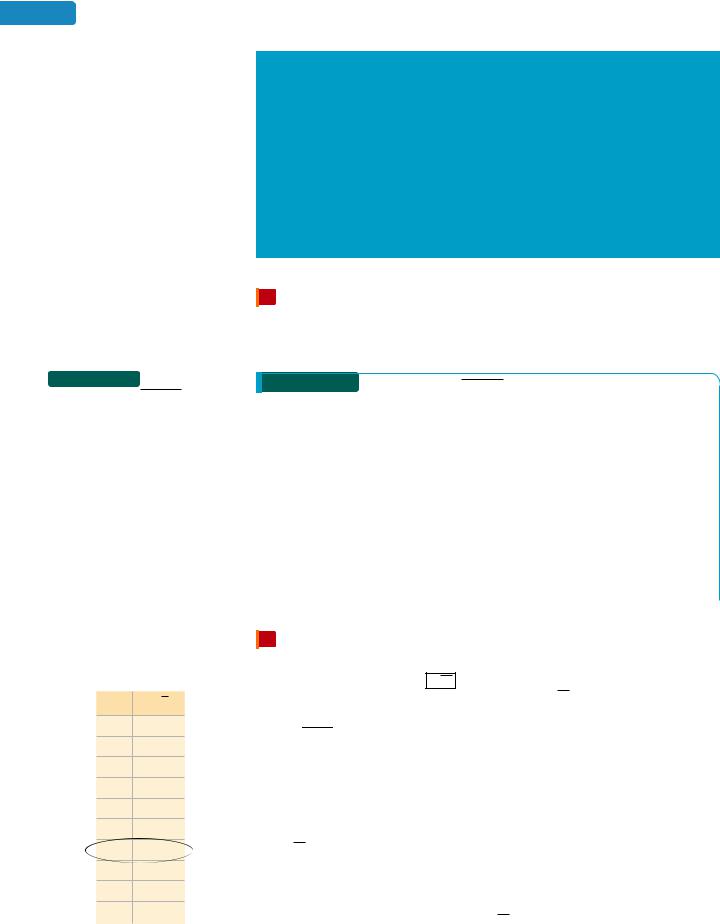
390 |
Chapter 4 Decimals |
 Self Check 72
Self Check 72
Evaluate a c2 b2 for c 17 and b 15.
Now Try Problem 81
n 1n
113.317
123.464
133.606
143.742
153.873
164.000
174.123
184.243
194.359
204.472
Solution |
|
|
|
|
|
||
12 3 C32 (4 1)1 |
|
D 12 |
3 C32 31 |
|
D |
Do the subtraction within the |
|
36 |
36 |
|
|||||
|
|
|
|
|
|
parentheses. |
|
12 |
3[9 3(6)] |
|
Within the brackets, evaluate the |
|
|||
|
|
|
|
|
|
exponential expression and the |
|
|
|
|
|
|
|
square root. |
|
12 |
3[9 18] |
|
|
Do the multiplication within the |
|
||
|
|
|
|
|
|
brackets. |
|
12 |
3[ 9] |
|
|
Do the subtraction within the |
|
||
|
|
|
|
|
|
brackets. |
|
12 |
( 27) |
|
|
Do the multiplication. |
|
||
15 |
|
|
Do the addition. |
|
|||
|
|||||||
4 Evaluate formulas involving square roots.
To evaluate formulas that involve square roots, we replace the letters with specific numbers and the then use the order2of operations rule.
Evaluate c a2 b2 for a 3 and b 4.
Strategy In the given formula, we will replace the letter a with 3 and b with 4. Then we will use the order of operations rule to find the value of the radicand.
WHY We need to know the value of the radicand before we can find its square root.
Solution |
|
|
||||||
|
2 |
|
|
|
|
|||
c |
a2 b2 |
This is the formula to evaluate. |
|
|||||
|
32 42 |
|
Replace a with 3 and b with 4. |
|
||||
|
1 |
|
|
|
|
Evaluate the exponential expressions. |
|
|
|
9 16 |
|
|
|
||||
|
|
25 |
|
|
|
Do the addition. |
|
|
5 |
|
|
|
|
|
Evaluate the square root. |
|
|
|
||||||||
perfect square, we can use the 1 key on a calculator1 or a table of square roots to find its approximate square root. For example, to find 17 using a scientific calculator,
5 Approximate square roots.
In Examples 2–7, we have found square roots of perfect squares. If a number is not a
we enter |
7 and press the square root key: |
|
|
|
|||
17 |
|
1 |
|
|
|
|
|
|
|
|
|
|
|
||
The display reads |
|
|
|
||||
4.123105626 |
1 |
|
|
||||
This result is an approximation, because the exact value of |
|
is a nonterminating |
|||||
17 |
|||||||
decimal1 that never repeats. If we round to the nearest thousandth, we have 17 4.123 Read as “is approximately equal to.”
To check this approximation, we square 4.123. (4.123)2 16.999129
Since the result is close to 17, we know that 17 4.123 .

A portion of the table of square roots from Appendix III on page A-00 is shown1 in the margin on the previous page. The table gives decimal approximations of square roots of whole numbers that are not perfect squares.To find an approximation of 17
to the nearest thousandth, we locate |
7 in the n-column of the table and scan directly |
||||
right, to the 1 |
|
-column, to find that |
1 |
|
4.123. |
n |
17 |
||||
|
EXAMPLE 8 |
Use a calculator to approximate each square root. Round to |
||||||||
the nearest hundredth. |
a. 1 |
|
b. 1 |
|
c. 1 |
|
|
|||
373 |
56.2 |
0.0045 |
||||||||
Strategy We will identify the radicand and find the square root using the 1 |
|
|||||||||
|
||||||||||
key. Then we will identify the digit in the thousandths column of the display.
WHY To round to the hundredths1 column, we must determine whether the digit in the thousandths1column is less than 5, or greater than or equal to 5.
Solution 1
a. From the calculator,1 we get 373 19.31320792. Rounded to the nearest hundredth, 373 19.31. 1
b. From the calculator,1 we get 56.2 7.496665926. Rounded to the nearest hundredth, 56.2 7.50.
c. From the calculator, we get 0.0045 0.067082039. Rounded to the nearest hundredth, 0.0045 0.07.
4.6 Square Roots |
391 |
 Self Check 8
Self Check 8
Use1a calculator to approximate each square root. Round to the nearest hundredth.
a. 153 b. 607.8
c. 0.076
Now Try Problems 87 and 91
ANSWERS TO SELF CHECKS
1. |
8 and 8 |
2. |
a. |
12 b. 9 3. |
a. |
4 |
b. 0.2 4. a. 12 b. 17 5. a. 88 b. 18 |
|
34 7. 8 |
|
|
12.37 b. 24.65 |
|
7 |
0.28 |
6. |
8. |
a. |
c. |
||||
|
|
S E C T I O N |
4.6 |
|
|
|
STUDY SET |
||||||||||||||||||
|
VOCABULARY |
|
|
|
|
|
|
|
|
|
|
|
|
|
|
|
|
||||||||
|
|
|
|
|
|
|
|
|
|
|
|
|
|
|
|
|
|||||||||
Fill in the blanks. |
|
|
|
|
|
|
|
|
|
|
|
|
|
|
|
|
|
|
|
|
|
||||
1. |
When we raise a number to the second power, we are |
||||||||||||||||||||||||
|
|
squaring it, or finding its |
|
|
|
|
|
|
|
. |
|
|
|
|
|||||||||||
2. |
The square |
|
|
|
|
of a given number is a number |
|||||||||||||||||||
|
|
whose square is the given number. |
|||||||||||||||||||||||
3. |
The symbol 1 |
|
|
|
is called a |
|
|
|
|
|
symbol. |
||||||||||||||
|
|
|
|
|
|
||||||||||||||||||||
4. |
Label the radicand, the radical expression, and the |
||||||||||||||||||||||||
|
|
|
|
|
|
|
|
|
|
164 |
|
|
|
|
|
|
|
|
|
|
|
|
|||
|
|
radical symbol in the illustration below. |
|||||||||||||||||||||||
|
|
|
|
|
|
|
|
|
|
|
|
|
|
|
|
|
|
|
|
|
|
|
|
|
|
|
|
|
|
|
|
|
|
|
|
|
|
|
|
|
|
|
|
|
|
|
|
||||
|
|
|
|
|
|
|
|
|
b |
|
|
|
|
|
|
|
|
|
|
|
|
||||
|
|
|
|
|
|
|
|
|
|
|
|
|
|
|
|
|
|
|
|
|
|
||||
|
|
|
|
|
|
|
|
|
|
|
|
|
|
|
|
|
|
|
|
|
|
||||
|
|
||||||||||||||||||||||||
|
|
|
|
||||||||||||||||||||||
5. |
Whole numbers such as 36 and 49, that are squares of |
||||||||||||||||||||||||
|
|
whole numbers, are called |
|
|
|
|
|
|
|
|
squares. |
||||||||||||||
|
The exact value of 1 |
|
|
|
|
|
|
|
|
|
|
||||||||||||||
6. |
|
|
is a |
|
|
|
|
|
|
|
decimal |
||||||||||||||
17 |
|
|
|
|
|
|
|||||||||||||||||||
that never repeats.
 CONCEPTS
CONCEPTS
Fill in the blanks. |
|
|
|
|
|
|
|
|
|
|
|
|
|
|
|
|
|
|
|
|
|
|
|
|
|
|
|
|
|
|
|
|
|
|
|
|
|
||||||||||
7. |
a. |
The square of 5 is |
|
|
|
|
|
|
, because 52 |
|
|
|
|
. |
|
|
|
|
|
||||||||||||||||||||||||||||
|
|
|
|
|
|
|
|
|
|
|
|
|
|
|
|||||||||||||||||||||||||||||||||
|
|
|
|
|
|
|
|
|
|
|
1 |
|
|
|
|
|
|
|
|
|
|
|
|
|
|
|
|
|
|
|
|
|
1 |
|
2 |
|
|
|
|
|
|
|
|
|
|||
|
|
|
|
|
|
|
|
|
|
|
|
|
|
|
|
|
|
|
|
|
|
|
|
|
|
|
|
|
|
|
|
|
|
|
|
||||||||||||
|
b. |
The square of |
|
is |
|
|
|
|
|
, because a |
|
b |
|
|
|
|
|
. |
|
|
|||||||||||||||||||||||||||
|
|
|
|
|
|
|
4 |
|
|
|
|
|
|
||||||||||||||||||||||||||||||||||
|
|
|
|
|
|
|
|
|
|
|
4 |
|
|
|
|
|
|
|
|
|
|
|
|
|
|
|
|
|
|
|
|
|
|
|
|
|
|
|
|
|
|
|
|
|
|||
8. Complete the list of perfect squares: 1, 4, |
|
|
|
||||||||||||||||||||||||||||||||||||||||||||
|
|
, 16, |
|
, |
|||||||||||||||||||||||||||||||||||||||||||
|
36, 49, 64, |
|
|
, 100, |
|
|
|
|
|
|
|
, 144, |
|
|
|
|
|
, 196, |
|
|
|
|
|
. |
|
|
|
||||||||||||||||||||
|
|
|
|
|
|
|
|
|
|
|
|
|
|
|
|||||||||||||||||||||||||||||||||
|
|
1 |
|
7, because |
|
|
|
|
2 49. |
|
|
|
|
|
|
|
|
|
|
|
|
|
|
|
|
|
|
|
|||||||||||||||||||
9. |
a. |
49 |
|
|
|
|
|
|
|
|
|
|
|
|
|
|
|
|
|
|
|
|
|
|
|
||||||||||||||||||||||
|
b. |
|
|
|
2, because |
|
|
|
|
2 4. |
|
|
|
|
|
|
|
|
|
|
|
|
|
|
|
|
|
|
|
|
|||||||||||||||||
|
|
|
4 |
|
|
|
|
|
|
|
|
|
|
|
|
|
|
|
|
|
|
|
|
|
|
|
|
||||||||||||||||||||
|
|
|
|
|
|
|
|
|
|
|
|
|
|
|
|
|
|
|
|
|
|
|
|
|
|
|
2 |
|
|
|
|
|
|
|
|
|
|
|
|
|
|
|
|
|
|
|
|
|
|
9 |
|
|
|
|
|
|
|
|
|
|
|
|
3 |
|
|
|
9 |
|
|
|
|
|
|
|
|
|
|
|
|
|
|
|
|
|
|||||||||||
|
|
|
|
|
|
|
|
|
|
|
|
|
|
|
|
|
|
|
|
|
|
|
|||||||||||||||||||||||||
10. |
a. |
B |
|
|
|
|
, because a |
|
b |
|
|
|
. |
|
|
|
|
|
|
|
|
|
|
|
|
|
|||||||||||||||||||||
16 |
|
4 |
|
|
|
|
|
|
|
|
|
|
|
|
|
|
|||||||||||||||||||||||||||||||
|
a. |
|
|
|
|
|
|
|
|
|
|
|
|
|
|
|
|
|
|
|
|
|
|
|
|
b. |
160 |
|
|
|
|
|
|
|
|
|
|
|
|
|
|||||||
|
11 |
|
|
|
|
|
|
|
|
|
|
|
|
|
|
|
|
|
|
|
|
|
|
|
|
|
|
|
|
|
|
|
|
|
|
||||||||||||
|
b. |
10.16 |
|
, because (0.4)2 |
0.16. |
|
|
|
|
|
|
|
|
|
|||||||||||||||||||||||||||||||||
11. Evaluate each square root. |
|
|
|
|
|
|
|
|
|
|
|
|
|
|
|
|
|
|
|
|
|
||||||||||||||||||||||||||
|
|
|
|
|
|
|
|
|
|
|
|
|
|
|
|
|
|
|
|
|
|
|
|
|
|
|
|
|
|
|
|
|
|
|
|
|
|
|
|
|
|
||||||
12. Evaluate each square root. |
|
|
|
|
|
|
|
|
|
|
|
|
|
|
|
|
|
|
|
|
|
||||||||||||||||||||||||||
|
|
1 |
|
|
|
|
|
|
|
|
|
|
|
|
|
|
1 |
|
|
|
|
|
|
|
|
|
|
|
|
|
|
|
1 |
|
|
|
|
|
|
||||||||
|
a. |
121 |
|
|
|
|
b. |
144 |
|
|
|
|
|
|
|
|
|
c. |
169 |
|
|
|
|||||||||||||||||||||||||
|
d. |
196 |
|
|
|
|
|
|
e. |
225 |
|
|
|
|
|
|
|
|
|
|
|
|
|
|
|
|
|
|
|
|
|
|
|||||||||||||||
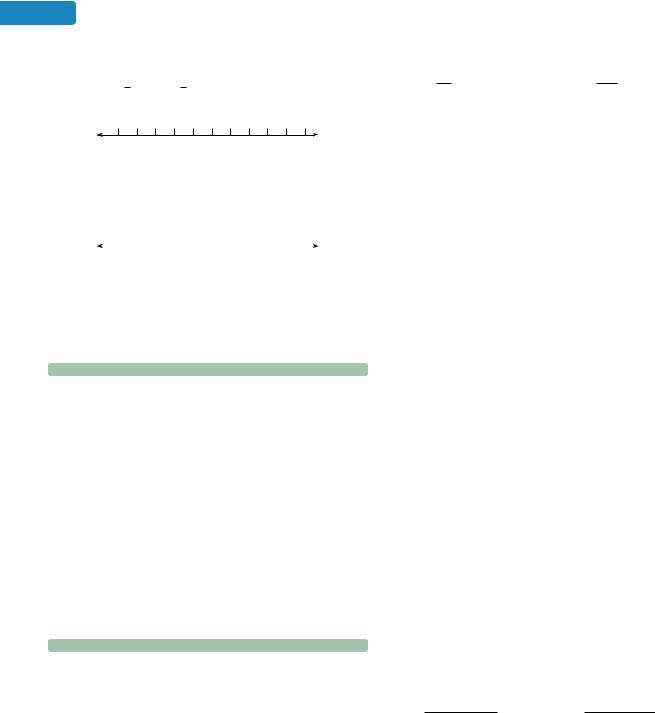
392 |
Chapter 4 Decimals |
13.In what1step of the1order of operations rule are square roots to be evaluated?
14.Graph 9 and 4 on a number line.
|
|
|
|
|
|
|
|
−5 − 4 −3 −2 −1 0 1 2 3 4 5 |
||||||||||||||||||||||||||||||||||||
15. |
Graph 1 |
|
and |
1 |
|
on a number line. (Hint: Use a |
||||||||||||||||||||||||||||||||||||||
3 |
7 |
|||||||||||||||||||||||||||||||||||||||||||
|
|
calculator or square root table to approximate each |
||||||||||||||||||||||||||||||||||||||||||
|
|
square root first.) |
|
|
|
|
|
|
|
|
|
|
|
|
|
|
|
|
|
|
|
|
|
|
|
|||||||||||||||||||
|
|
|
|
|
|
|
|
|
|
|
|
|
|
|
|
|
|
|
|
|
|
|
|
|
|
|
|
|
|
|||||||||||||||
|
|
|
|
|
|
|
|
|
|
|
|
|
|
|
|
|
|
|
|
|
|
|
|
|
|
|
|
|
|
|
||||||||||||||
|
|
|
|
|
|
|
|
−5 − 4 −3 −2 −1 0 1 2 3 4 5 |
||||||||||||||||||||||||||||||||||||
16. |
a. |
Between what two whole numbers would 1 |
|
|
||||||||||||||||||||||||||||||||||||||||
19 |
||||||||||||||||||||||||||||||||||||||||||||
|
|
|
be located when graphed on a number line? |
|||||||||||||||||||||||||||||||||||||||||
|
|
b. Between what two whole numbers would 1 |
|
|
||||||||||||||||||||||||||||||||||||||||
|
|
50 |
||||||||||||||||||||||||||||||||||||||||||
|
|
|
be located when graphed on a number line? |
|||||||||||||||||||||||||||||||||||||||||
|
NOTATION |
|
|
|
|
|
|
|
|
|
|
|
|
|
|
|
|
|
|
|
|
|
|
|
||||||||||||||||||||
|
|
|
|
|
|
|
|
|
|
|
|
|
|
|
|
|
|
|
|
|
|
|
|
|||||||||||||||||||||
Fill in the blanks. |
|
|
|
|
|
|
|
|
|
|
|
|
|
|
|
|
|
|
|
|
|
|
|
|||||||||||||||||||||
17. |
a. |
The symbol 1 is used to indicate a positive |
||||||||||||||||||||||||||||||||||||||||||
|
|
|
|
|
|
|
|
|
|
|
. |
1 |
|
|
|
|
|
|
|
|
|
|
|
|
|
|
|
|
|
|
|
|
||||||||||||
|
|
b. |
The symbol |
|
|
|
|
|
is used to indicate the |
|
|
|
||||||||||||||||||||||||||||||||
|
|
|
|
|
|
|
|
|
||||||||||||||||||||||||||||||||||||
|
|
|
square root of a positive number. |
|||||||||||||||||||||||||||||||||||||||||
18. |
41 |
|
|
means 4 |
|
|
|
1 |
|
|
|
|
|
|
|
|
|
|
|
|
|
|
|
|
|
|
|
|||||||||||||||||
|
|
|
|
|
|
|
|
|
|
|
|
|
|
|
|
|
|
|
|
|
|
|||||||||||||||||||||||
9 |
9. |
|
|
|
|
|
|
|
|
|
|
|
|
|
|
|
|
|||||||||||||||||||||||||||
Complete each solution to evaluate the expression. |
||||||||||||||||||||||||||||||||||||||||||||
19. |
1 |
|
|
|
1 |
|
|
|
|
|
|
|
|
|
|
|
|
|
|
|
|
|
|
|
|
|
|
|
|
|
|
|
||||||||||||
49 |
64 |
|
|
|
|
|
|
|
|
|
|
|
|
|
|
|
|
|
|
|
|
|
|
|||||||||||||||||||||
|
|
|
1 |
|
|
|
|
|
|
|
|
|
|
|
|
|
|
|
|
|
|
|
|
|||||||||||||||||||||
20. |
21 |
|
|
|
|
|
51 |
|
|
|
|
2( |
|
|
|
) 5( |
|
) |
|
|
|
|
|
|
|
|||||||||||||||||||
100 |
25 |
|
|
|
|
|
|
|
|
|
|
|
||||||||||||||||||||||||||||||||
|
|
|
|
|
|
|
|
|
|
25 |
|
|
|
|
|
|
|
|
|
|
|
|||||||||||||||||||||||
|
|
|
|
|
|
|
|
|
|
|
|
|
|
|
|
|
|
|
|
|||||||||||||||||||||||||
|
|
|
5 |
|
|
|
|
|
|
|
|
|
|
|
|
|
|
|
|
|||||||||||||||||||||||||
 GUIDED PRACTICE
GUIDED PRACTICE
Find the two square roots of each number. See Example 1.
21. |
25 |
22. |
1 |
23. |
6 |
24. |
44 |
Evaluate each square root without using a calculator.
See Example 2. |
|
|
|
|
|
|
|
||||||||
29. |
|
|
|
|
|
30. |
|
|
|
|
|||||
16144 |
|
16121 |
|||||||||||||
25. |
1 |
|
|
|
|
|
|
26. |
164 |
|
|
||||
27. |
|
|
9 |
|
|
|
|
|
28. |
|
|
|
|
|
|
31. |
|
|
|
|
|
|
|
|
32. |
|
|
|
|
|
|
|
|
|
|
|
|
|
|
|
|
|
|
|
|
||
|
|
49 |
|
81 |
|
||||||||||
Use a calculator to evaluate each square root. |
||||||||
See Objective 1, Using Your Calculator. |
||||||||
|
1 |
|
|
|
1 |
|
|
|
33. |
961 |
34. |
841 |
|
||||
35. |
3,969 |
36. |
5,625 |
|||||
Evaluate each square root without using a calculator.
See Example 3.
37. |
B |
|
4 |
|
|
|
|
|
|
|
|
|
|
|
|
|
|
|
|
|
|
|
|
|
|
|
|
|
|
|
|
|
|
|
|
38. |
B |
|
|
36 |
|
|
|
|
|
|
|
|
|
|
|
|
|
|
|
|
|||||||||||||||||
25 |
|
|
|
|
|
|
|
|
|
|
|
|
|
|
|
|
|
|
|
|
|
|
|
|
|
|
|
|
|
121 |
|
|
|
|
|
|
|
|
|
|
|
|
|
|
|
|
|||||||||||||||||||||||||||
|
|
|
|
|
|
|
|
|
|
|
|
|
|
|
|
|
|
|
|
|
|
|
|
|
|
|
|
|
|
|
|
|
|
|
|
|
|
|
|
|
|
|
|
|
|
|
|
|
|
|
|
|
|
|
|
|
|
|
|
|
|
|
|
|
|||||||||
39. |
B |
|
16 |
|
|
|
|
|
|
|
|
|
|
|
|
|
|
|
|
|
|
|
|
|
|
|
|
|
|
40. |
B |
|
64 |
|
|
|
|
|
|
|
|
|
|
|
|
|
|
|
|
||||||||||||||||||||||||
|
|
|
|
|
|
|
|
|
|
|
|
|
|
|
|
|
|
|
|
|
|
|
|
|
|
|
|
|
|
|
|
|
|
|
|
|
|
|
|
|
|
|
|
|
|
||||||||||||||||||||||||||||
9 |
|
|
|
|
|
|
|
|
|
|
|
|
|
|
|
|
|
|
|
|
|
|
|
|
|
|
|
25 |
|
|
|
|
|
|
|
|
|
|
|
|
|
|
|
|
|||||||||||||||||||||||||||||
41. |
B |
|
1 |
|
|
|
|
|
|
|
|
|
|
|
|
|
|
|
|
|
|
|
|
|
|
|
|
|
|
|
42. |
B |
|
1 |
|
|
|
|
|
|
|
|
|
|
|
|
|
|
|
|
|||||||||||||||||||||||
|
|
|
|
|
|
|
|
|
|
|
|
|
|
|
|
|
|
|
|
|
|
|
|
|
|
|
|
|
|
|
|
|
|
|
|
|
|
|
|
|
|
|
|
|
|||||||||||||||||||||||||||||
81 |
|
|
|
|
|
|
|
|
|
|
|
|
|
|
|
|
|
|
|
|
|
|
|
|
|
|
4 |
|
|
|
|
|
|
|
|
|
|
|
|
|
|
|
|
||||||||||||||||||||||||||||||
43. |
10.64 |
|
|
|
|
|
|
|
|
|
|
|
|
|
|
|
|
|
|
|
|
|
|
|
|
|
|
|
44. |
10.36 |
|
|
|
|
|
|
|
|
|
|
|
|
|
|
|
|
|||||||||||||||||||||||||||
45. |
1 |
|
|
|
|
|
|
|
|
|
|
|
|
|
|
|
|
|
|
|
|
|
|
|
|
|
46. |
1 |
|
|
|
|
|
|
|
|
|
|
|
|
|
|
|
|
|||||||||||||||||||||||||||||
0.81 |
|
|
|
|
|
|
|
|
|
|
|
|
|
|
|
|
|
|
|
|
|
|
0.49 |
|
|
|
|
|
|
|
|
|
|
|
|
|
|||||||||||||||||||||||||||||||||||||
47. |
10.09 |
|
|
|
|
|
|
|
|
|
|
|
|
|
|
|
|
|
|
|
|
|
|
|
|
|
|
|
48. |
10.01 |
|
|
|
|
|
|
|
|
|
|
|
|
|
|
|
|
|||||||||||||||||||||||||||
Evaluate each expression without using a calculator. |
|
||||||||||||||||||||||||||||||||||||||||||||||||||||||||||||||||||||||||
See Example 4. |
|
|
|
|
|
|
|
|
|
|
|
|
|
|
|
|
|
|
|
|
|
|
|
|
|
|
|
|
|
|
|
|
|
|
|
|
|
|
|
|
|
|
|
|
|
|
|
|
|
|
|
|
|||||||||||||||||||||
53. |
|
|
|
|
|
|
|
|
|
|
|
|
|
|
|
|
|
|
|
|
|
|
|
54. |
|
|
|
|
|
|
|
|
|
|
|
|
|||||||||||||||||||||||||||||||||||||
81144 |
|
|
116 |
|
|
|
|
|
|
|
|
|
|
|
|
|
11 1196 |
|
|
|
|||||||||||||||||||||||||||||||||||||||||||||||||||||
49. |
136 11 |
|
|
|
|
|
|
|
|
|
|
|
|
|
|
|
|
|
50. |
1100 |
1 |
|
|
|
|
|
|
|
|
|
|||||||||||||||||||||||||||||||||||||||||||
51. |
|
|
|
|
|
|
|
|
|
|
|
|
|
|
|
|
|
|
|
|
|
|
|
|
|
|
|
|
|
|
|
|
|
|
|
52. |
|
|
|
|
136 |
|
|
|
|
|
|
|
|
|
|||||||||||||||||||||||
|
|
|
|
|
|
|
|
|
|
|
|
|
|
|
49 |
|
|
|
|
|
|
|
|
|
|
|
|
|
|
|
|
4 |
|
|
|
|
|
|
|
|
|||||||||||||||||||||||||||||||||
55. |
|
|
|
|
|
|
|
|
|
|
|
|
|
|
|
|
|
|
|
|
|
|
|
|
|
|
|
|
|
|
56. |
|
|
|
|
|
|
|
|
|
|
|
16 |
|
|
|
|
||||||||||||||||||||||||||
|
|
|
|
|
|
|
|
|
|
|
|
|
|
|
|
|
|
|
|
|
|
|
|
|
|
|
|
|
|
|
|
|
|
|
|
|
|
|
|
|
|
|
|
|
|
|
|
|
|
|
|
|
|
|
|
||||||||||||||||||
|
|
|
|
|
|
|
|
225 |
|
|
|
|
|
144 |
|
|
|
|
|
|
|
|
|
|
|
|
|
|
|
|
|
|
|
|
169 |
16 |
|
|
|||||||||||||||||||||||||||||||||||
Evaluate each expression without using a calculator. |
|
||||||||||||||||||||||||||||||||||||||||||||||||||||||||||||||||||||||||
See Example 5. |
|
|
|
|
|
|
|
|
|
|
|
|
|
|
|
|
|
|
|
|
|
|
|
|
|
|
|
|
|
|
|
|
|
|
|
|
|
|
|
|
|
|
|
|
|
|
|
|
|
|
|
|
|||||||||||||||||||||
61. |
|
|
|
|
|
|
|
|
|
|
|
14 |
|
|
|
|
|
|
|
|
|
|
|
|
62. |
6 |
|
|
|
|
|
|
|
|
|
|
|
|
|
||||||||||||||||||||||||||||||||||
41169 2 |
|
|
|
|
|
|
|
|
|
|
|
|
8181 51 |
|
|
|
|||||||||||||||||||||||||||||||||||||||||||||||||||||||||
57. |
4 |
125 |
|
|
|
|
|
|
|
|
|
|
|
|
|
|
|
|
|
|
|
|
|
|
|
|
|
|
|
|
58. |
2 |
1 |
|
|
|
|
|
|
|
|
|
|
|
|
|
|
|
|
|
|
|
|
|
|
|
|||||||||||||||||
59. |
10 |
1 |
|
|
|
|
|
|
|
|
|
|
|
|
|
|
|
|
|
|
|
|
|
|
60. |
40 |
1 |
|
|
|
|
|
|
|
|
|
|
|
|
|
|
|
|
||||||||||||||||||||||||||||||
196 |
|
|
|
|
|
|
|
|
|
|
|
|
|
|
|
|
|
|
|
|
4 |
|
|
|
|
|
|
|
|
|
|
|
|
|
|
|
|||||||||||||||||||||||||||||||||||||
|
|
|
|
|
|
|
|
|
|
|
|
|
|
|
|
|
|
|
|
|
|
|
|
|
|
|
|
|
|
|
|
|
|
|
|
|
|
|
|
|
|
|
|
|
|
|
|
|
|
||||||||||||||||||||||||
63. |
8 |
|
|
|
|
|
|
|
51 |
|
|
|
|
|
|
|
|
|
|
|
|
|
|
64. |
3 |
|
|
|
|
|
|
|
|
|
21 |
|
|
||||||||||||||||||||||||||||||||||||
16 |
225 |
|
|
|
|
|
|
|
|
|
|
|
|
|
|
169 |
225 |
||||||||||||||||||||||||||||||||||||||||||||||||||||||||
Evaluate each expression without using a calculator. |
|
||||||||||||||||||||||||||||||||||||||||||||||||||||||||||||||||||||||||
See Example 6. |
|
|
|
|
|
|
|
|
|
|
|
1 |
|
|
|
|
|
|
|
|
|
|
|
|
|
|
|
|
|
|
|
|
|
|
|
|
|
|
|
|
|
|
|
|
|
|
|
|
|
|
|||||||||||||||||||||||
65. |
15 4 C52 (6 1) |
|
D |
|
|
|
|
|
|
|
|
|
|
|
|
|
|
|
|
|
|
|
|
|
|
|
|
|
|
|
|
|
|
||||||||||||||||||||||||||||||||||||||||
4 |
|
|
|
|
|
|
|
|
|
|
|
|
|
|
|
|
|
|
|
|
|
|
|
|
|
|
|
|
|
|
|||||||||||||||||||||||||||||||||||||||||||
66. |
18 2 C42 (7 3)1 |
|
|
D |
|
|
|
|
|
|
|
|
|
|
|
|
|
|
|
|
|
|
|
|
|
|
|
|
|
|
|
|
|
|
|||||||||||||||||||||||||||||||||||||||
9 |
|
|
|
|
|
|
|
|
|
|
|
|
|
|
|
|
|
|
|
|
|
|
|
|
|
|
|
|
|
|
|||||||||||||||||||||||||||||||||||||||||||
67. |
50 C(62 24) 9 |
1 |
|
|
|
|
|
D |
|
|
|
|
|
|
|
|
|
|
|
|
|
|
|
|
|
|
|
|
|
|
|
|
|
|
|
|
|
|
|||||||||||||||||||||||||||||||||||
25 |
|
|
|
|
|
|
|
|
|
|
|
|
|
|
|
|
|
|
|
|
|
|
|
|
|
|
|
|
|
|
|||||||||||||||||||||||||||||||||||||||||||
68. |
40 C(72 40) 7 |
1 |
|
|
|
|
|
|
|
D |
|
|
|
|
|
|
|
|
|
|
|
|
|
|
|
|
|
|
|
|
|
|
|
|
|
|
|
|
|
|
|||||||||||||||||||||||||||||||||
64 |
|
|
|
|
|
|
|
|
|
|
|
|
|
|
|
|
|
|
|
|
|
|
|
|
|
|
|
|
|
|
|||||||||||||||||||||||||||||||||||||||||||
69. |
1 |
|
|
|
|
|
3 |
1 |
52 2 |
1 |
|
|
|
|
|
2 |
|
|
|
|
|
|
|
|
|
|
|
|
|
|
|
|
|
|
|
|
|
|
|
|
|
|
|
|
|
|
|
|
|||||||||||||||||||||||||
196 |
225 |
|
|
|
|
|
|
|
|
|
|
|
|
|
|
|
|
|
|
|
|
|
|
|
|
|
|
|
|
|
|
|
|
||||||||||||||||||||||||||||||||||||||||
70. |
1 |
|
|
|
|
|
|
2 |
1 |
72 3 |
1 |
|
|
|
|
|
2 |
|
|
|
|
|
|
|
|
|
|
|
|
|
|
|
|
|
|
|
|
|
|
|
|
|
|
|
|
|
|
|
|
||||||||||||||||||||||||
169 |
144 |
|
|
|
|
|
|
|
|
|
|
|
|
|
|
|
|
|
|
|
|
|
|
|
|
|
|
|
|
|
|
|
|
||||||||||||||||||||||||||||||||||||||||
|
1 |
|
|
|
|
|
6(22) |
|
|
|
|
|
|
|
|
|
|
|
|
|
|
|
|
|
|
|
|
|
|
|
|
|
|
3(16) |
|
|
|
|
|
|
|
||||||||||||||||||||||||||||||||
|
16 |
|
|
|
|
|
|
|
|
|
|
|
|
|
|
|
|
|
|
49 |
|
|
|
|
|
|
|||||||||||||||||||||||||||||||||||||||||||||||
71. |
|
|
|
|
|
|
|
|
|
1 |
|
|
|
|
|
|
|
|
|
|
|
|
|
|
|
|
|
|
|
|
|
|
|
|
|
72. |
1 |
|
|
|
|
|
1 |
|
|
|
|
|
|
|
|
|
|||||||||||||||||||||
|
|
|
|
|
|
|
|
|
4 |
|
|
|
|
|
|
|
|
|
|
|
|
|
|
|
|
|
|
|
|
|
16 |
64 |
|
|
|
|
|
|
|
||||||||||||||||||||||||||||||||||
|
|
|
|
|
|
|
|
|
|
|
|
|
|
|
|
|
|
|
|
|
|
|
|
|
|
|
|
|
|
|
|
|
|
|
|
|
|
|
|
|
|
|
|
|
|
|
|
|
|
|
|
|
|
|
|
|
|
|
|
|
|
|
|
|
|
|
|
|
|
||||
|
|
|
|
1 |
|
|
|
|
|
|
|
|
|
|
|
|
|
|
9 |
|
|
|
|
|
|
|
|
|
|
|
|
|
|
|
|
|
|
|
25 |
|
|
64 |
|
|
|
|
|
|
|||||||||||||||||||||||||
73. |
B |
|
|
|
|
|
|
|
|
|
|
B |
|
|
|
|
|
|
|
|
|
|
|
|
|
|
|
|
|
|
74. |
B |
|
|
|
|
|
|
|
|
|
|
B |
|
|
|
|
|
|
|
|
|
|||||||||||||||||||||
16 |
25 |
|
|
|
|
|
|
|
|
|
|
|
|
|
|
|
|
|
9 |
|
|
|
|
|
81 |
|
|||||||||||||||||||||||||||||||||||||||||||||||
75. |
5 |
1 |
|
|
|
|
|
|
|
1 |
|
|
|
|
|
2 |
( 2)2 |
|
|
|
|
|
|
|
|
|
|
|
|
76. |
1 |
1 |
|
2( 2)(3)3 |
|||||||||||||||||||||||||||||||||||||||
|
49 |
|
|
|
|
|
|
|
|
|
|
|
|
64 |
|||||||||||||||||||||||||||||||||||||||||||||||||||||||||||
77. |
(62)10.04 2.36 |
|
|
|
|
|
|
|
|
|
|
|
78. |
(52)10.25 4.7 |
|
||||||||||||||||||||||||||||||||||||||||||||||||||||||||||
|
1 31 |
|
|
|
|
|
|
|
52 |
|
|
|
|
|
|
|
|
|
|
|
|
|
1 2 |
1 |
|
|
|
|
|
|
6 |
2 |
|||||||||||||||||||||||||||||||||||||||||
79. |
1.44 |
|
|
|
|
|
|
|
|
|
|
|
80. |
1.21 |
|||||||||||||||||||||||||||||||||||||||||||||||||||||||||||
Evaluate each formula without using a calculator. |
|
||||||||||||||||||||||||||||||||||||||||||||||||||||||||||||||||||||||||
See Example 7. |
|
|
|
|
|
2 |
|
|
|
|
|
|
|
|
|
|
|
|
|
|
|
|
|
|
|
|
|
|
|
|
|
|
|
|
|
|
|
|
|
|
|
|
|
|
|
|
|
|
|
|
|||||||||||||||||||||||
|
|
|
|
|
|
|
|
|
|
|
|
|
|
|
|
|
|
|
|
|
|
|
|
|
|
|
|
|
|
|
|
|
|
|
|
|
|
|
|
|
|
|
|
|
|
|
|
|
|
|
|
|
|
|
|
|
|
|
|
|
|
|
|
||||||||||
81. |
Evaluate c |
a2 b2 |
|
for a 9 and b 12. |
|||||||||||||||||||||||||||||||||||||||||||||||||||||||||||||||||||||
82. |
Evaluate c |
|
|
|
a2 b2 |
|
for a 6 and b 8. |
|
|||||||||||||||||||||||||||||||||||||||||||||||||||||||||||||||||
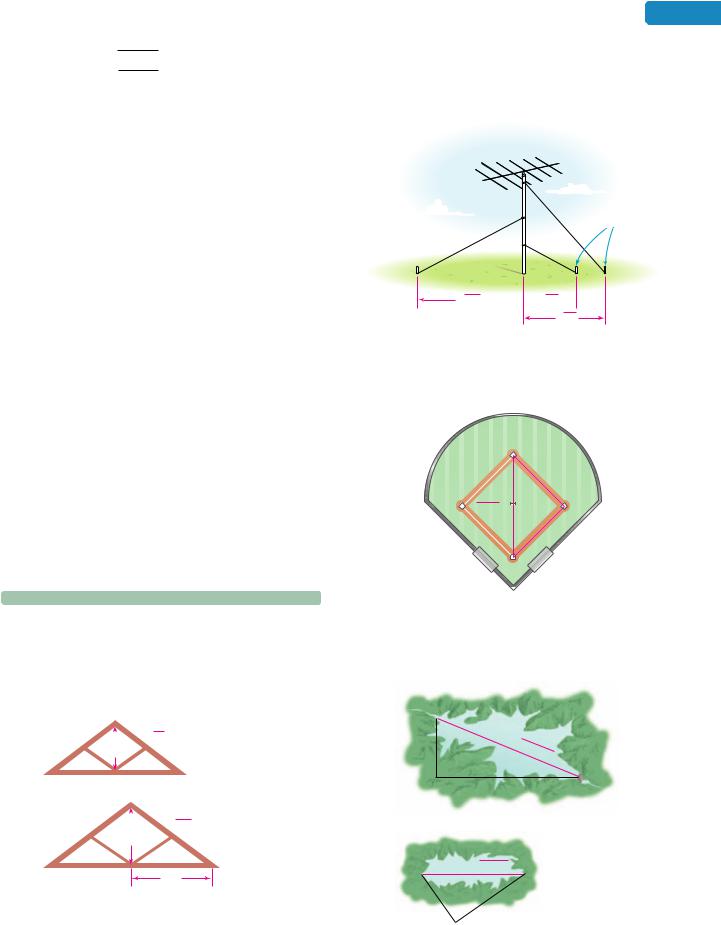
83.Evaluate a 2c2 b2 for c 25 and b 24.
84.Evaluate b c2 a2 for c 17 and a 8.
Use a calculator (or the square root table in Appendix III) to complete each square root table. Round to the nearest thousandth when an answer is not exact. See Example 8.
85. |
|
|
86. |
|
|
|
|
Square |
|
|
Square |
|
Number |
Root |
|
Number |
Root |
|
|
|
|
|
|
|
1 |
|
|
10 |
|
|
2 |
|
|
20 |
|
|
3 |
|
|
30 |
|
|
4 |
|
|
40 |
|
|
5 |
|
|
50 |
|
|
6 |
|
|
60 |
|
|
7 |
|
|
70 |
|
|
8 |
|
|
80 |
|
|
9 |
|
|
90 |
|
|
10 |
|
|
100 |
|
|
|
|
|
|
|
Use a calculator (or a square root table) to approximate each of |
|||||||
the following to the nearest hundredth. See Example 8. |
|||||||
|
1 |
|
|
1 |
|
|
|
87. |
15 |
88. |
51 |
|
|
||
89. |
66 |
90. |
204 |
|
|||
91. |
1 |
|
|
92. |
1 |
|
||
24.05 |
70.69 |
|||||||
93. |
1 |
|
|
94. |
|
|
|
|
11.1 |
0.145 |
|||||||
Use a calculator to approximate each of the following to the nearest thousandth. See Example 8.
 APPLICATIONS
APPLICATIONS
In the following problems, some lengths are expressed as square roots. Solve each problem by evaluating any square roots. You may need to use a calculator. If so, round to the nearest tenth when an answer is not exact.
95.CARPENTRY Find the length of the slanted side of each roof truss shown below.
a.

 25 ft 3 ft
25 ft 3 ft
 4 ft
4 ft 

b.

 100 ft 6 ft
100 ft 6 ft
8 ft
4.6 Square Roots |
393 |
96.RADIO ANTENNAS Refer to the illustration below. How far from the base of the antenna is each guy wire anchored to the ground? (The measurements are in feet.)
Anchor
points
Anchor
point
√144 
 √16
√16 
√36
97.BASEBALL The illustration below shows some dimensions of a major league baseball field. How far is it from home plate to second base?
90 ft
√16,200 ft
90 ft
98.SURVEYING Refer to the illustration below. Use the imaginary triangles set up by a surveyor to
find the length of each lake. (The measurements are in meters.)
a.
Length: √
318,096
b.
Length: √93,025
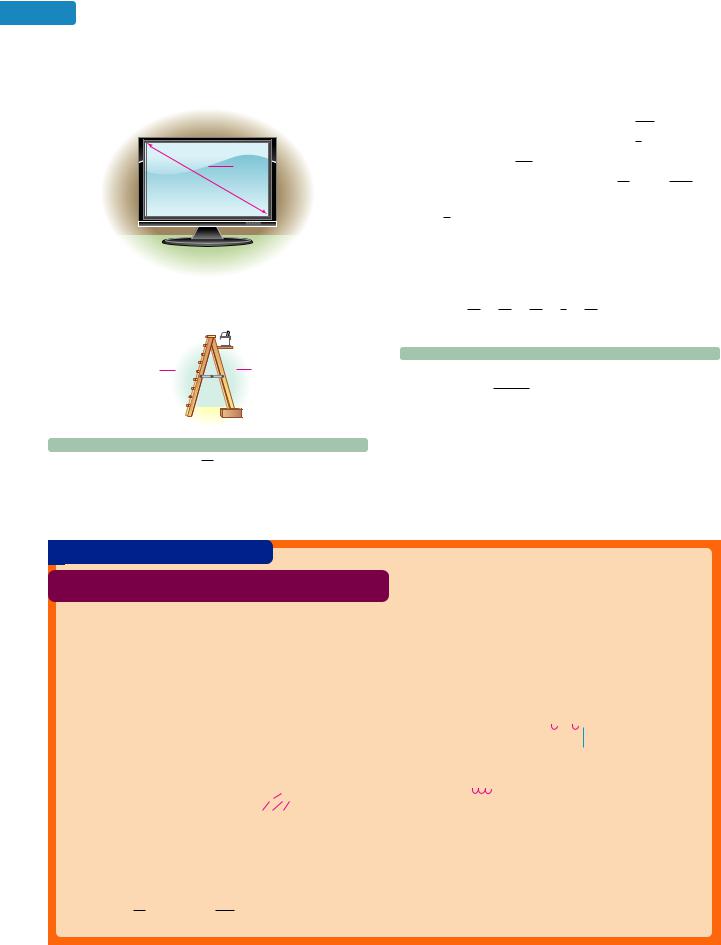
394 |
Chapter 4 Decimals |
99.FLATSCREEN TELEVISIONS The picture screen on a television set is measured diagonally. What size screen is shown below?
√1,764 in. |
100.LADDERS A painter’s ladder is shown below. How long are the legs of the ladder?
√225 ft |
√169 ft |
 WRITING 1
WRITING 1
101. When asked to find 16, a student answered 8. Explain his misunderstanding of the concept of square root.
102.Explain the difference between the square and the square root of a number. Give an example1 .
103.What is a nonterminating decimal? Use an example in your explanation1 .
104.a. How would you check whether1 389 1 17? b. How would you check whether 7 2.65?
105.Explain1 why 4 does not represent a real number.
106.Is there a difference between 25 and 25? Explain.
107.6 2.449. Explain why an symbol is used and
not an symbol.
108. Without1 evaluating1 1 the1following1 square roots, determine which is the largest and which is the smallest. Explain how you decided.
23, 27, 11, 6, 20
 REVIEW
REVIEW
109.Multiply: 6.75 12.2
110.Divide: 5.7 18.525
111.Evaluate: (3.4)3
112.Add: 23.45 76 0.009 3.8
STUDY SKILLS CHECKLIST
 Do You Know the Basics?
Do You Know the Basics?
The key to mastering the material in Chapter 4 is to know the basics. Put a checkmark in the box if you can answer “yes” to the statement.
I have memorized the place-value chart on page 317.
I know the rules for rounding a decimal to a certain decimal place value by identifying the rounding digit and the test digit.
I know how to add decimals using carrying and how to subtract decimals using borrowing.
1 |
1 |
|
9 |
|
7.18 |
6 |
10 14 |
|
|
537.0 4 |
|
|
154.20 |
2 3. 9 8 |
|
|
46.03 |
||
513. 0 6 |
|||
|
207.41 |
||
|
|
I have memorized the list of perfect squares on
page 387 and can find their square roots. |
|
216 4 |
2121 11 |
I know how to multiply and divide decimals and locate the decimal point in the answer.
1.84 |
|
|
2.8 |
|
3.4 |
|
|
||
9.5 2 |
||||
7. 6 |
|
|
|
|
68 |
|
|||
1104 |
|
|||
|
|
|
||
12880 |
|
|
272 |
|
|
272 |
|||
13.984 |
|
|||
|
|
0 |
||
|
|
|
||
I know how to use division to write a fraction as a decimal.
|
|
0.6 |
|
|
3 |
|
5 |
|
|
0.6 |
3.0 |
|||
5 |
30 |
|
||
|
|
0 |
||
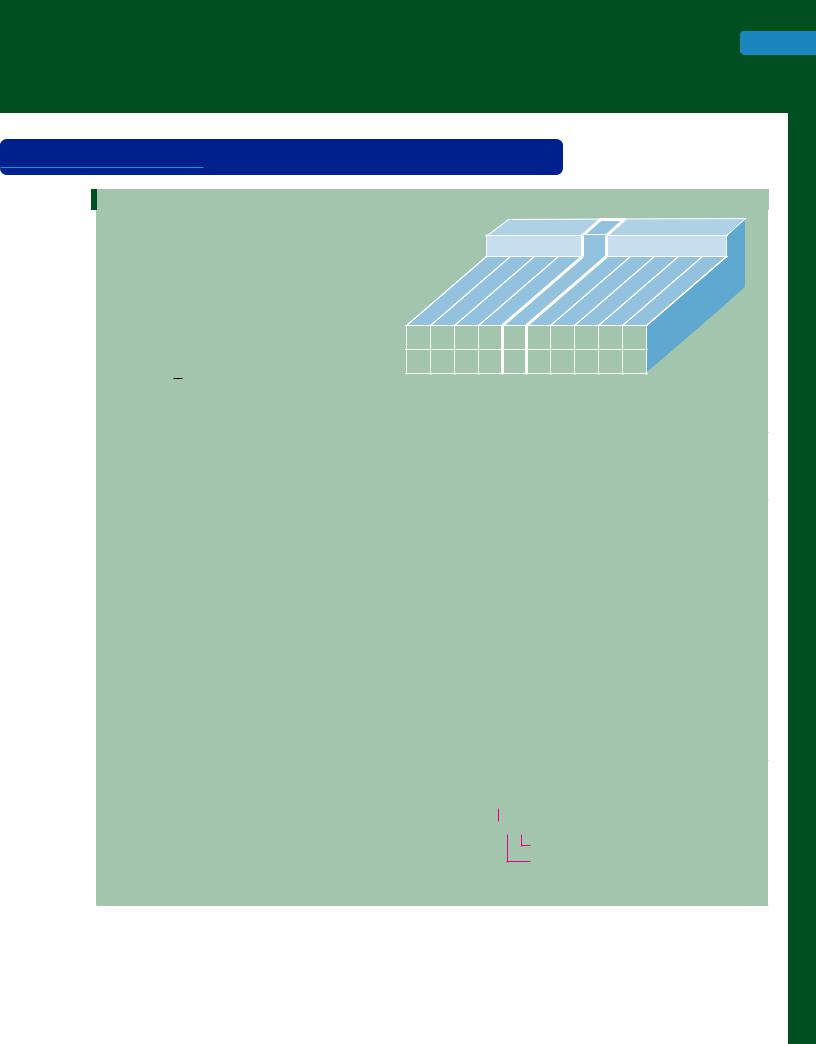
395
C H A P T E R 4 SUMMARY AND REVIEW
 S E C T I O N 4.1 An Introduction to Decimals
S E C T I O N 4.1 An Introduction to Decimals
DEFINITIONS AND CONCEPTS
The place-value system for whole numbers can be extended to create the decimal numeration system.
The place-value columns to the left of the decimal point form the whole-number part of the decimal number. The value of each of those columns is 10 times greater than the column directly to its right.
The columns to the right of the decimal point form the fractional part. Each of those columns has a value that is 101 of the value of the place directly to its left.
To write a decimal number in expanded form (expanded notation) means to write it as an addition of the place values of each of its digits.
To read a decimal:
1.Look to the left of the decimal point and say the name of the whole number.
2.The decimal point is read as “and.”
3.Say the fractional part of the decimal as a whole number followed by the name of the last place-value column of the digit that is the farthest to the right.
We can use the steps for reading a decimal to write it in words.
The procedure for reading a decimal can be applied in reverse to convert from written-word form to standard form.
EXAMPLES
|
|
|
|
|
|
Whole-number part |
|
|
|
|
|
|
|
Fractional part |
|
||||||||||||||
|
|
|
|
|
|
|
|
|
|
|
|
|
|
|
|
|
|
|
|
|
|
|
|
|
|
ths |
ths |
||
|
|
|
|
|
|
|
Tens |
Ones |
|
|
|
Ten |
|
|
|
|
|
|
|
|
|
|
|
||||||
|
|
|
|
|
|
|
|
|
|
|
|
|
ths |
|
-thousand-thousand |
||||||||||||||
|
|
|
Thousands |
|
|
|
|
|
|
point |
|
|
|
|
|
|
ths |
|
|
|
|
||||||||
|
|
|
|
|
|
|
|
|
|
|
|
|
Hundred |
|
|
|
|
|
|
|
|||||||||
|
|
|
|
|
Hundreds |
|
|
|
Decimal |
|
|
|
ths |
|
Thousand |
ndred |
|
||||||||||||
|
|
|
|
|
|
|
|
|
|
|
|
|
|
|
|
|
|
|
Ten |
|
|
|
|
||||||
|
|
|
|
|
|
|
|
|
|
|
|
|
|
|
|
|
|
|
|
|
|
|
Hu |
|
|||||
|
2 |
8 |
. |
|
9 |
3 |
|
4 |
1 |
|
|
|
|
|
|
|
|
|
|
||||||||||
|
|
|
|
|
|
|
|
|
|
|
|
|
|
|
|
|
|
|
|
|
|
|
|
|
|||||
|
1,000 100 10 |
1 |
|
|
1 |
|
1 |
|
|
1 |
1 |
|
1 |
|
|
|
|
|
|
|
|||||||||
|
|
|
|
–– |
––– |
|
–––– |
|
––––– |
|
–––––– |
|
|
|
|
|
|||||||||||||
|
|
|
|
|
|
|
|
|
10 |
100 |
|
1,000 |
10,000 |
100,000 |
|
|
|
|
|
||||||||||
|
|
|
|
|
|
|
|
|
|
|
|
|
|
|
|
|
|
|
|
|
|
|
|
|
|
|
|
|
|
|
|
|
|
|
|
|
|
|
|
|
|
|
|
|
|
|
|
|
|
|
|
|
|
|
|
|
|
|
|
|
|
|
|
|
|
|
|
|
|
|
|
|
|
|
|
|
|
|
|
|
|
|
|
|
|
|
|
|
|
|
|
|
|
|
|
|
|
|
|
|
|
|
|
|
|
|
|
|
|
|
|
|
|
|
|
|
|
|
|
|
|
|
|
|
|
|
|
|
|
|
|
|
|
|
|
|
|
|
|
|
|
|
|
|
|
|
|
|
|
|
|
|
|
|
|
|
|
|
|
|
|
|
|
|
|
|
|
|
|
|
|
|
|
|
|
|
|
|
|
|
|
|
|
|
|
|
|
|
|
|
|
|
|
|
|
|
|
|
|
|
|
|
|
|
|
|
|
|
|
|
|
|
|
|
|
|
|
|
|
|
|
|
|
|
|
|
|
|
|
|
|
|
|
|
|
|
|
|
|
|
|
|
|
|
|
|
|
|
|
|
|
|
|
|
|
|
|
|
|
|
|
|
|
|
|
|
|
|
|
|
|
|
|
|
|
|
|
|
|
|
|
|
|
|
|
|
|
|
|
|
|
|
|
|
|
|
|
|
|
Negative twelve and sixty-five ten-thousandths
12.0065
This is the ten-thousandths place-value column. Two place holder 0’s must be inserted here so that the last digit in 65 is in the tenthousandths column.
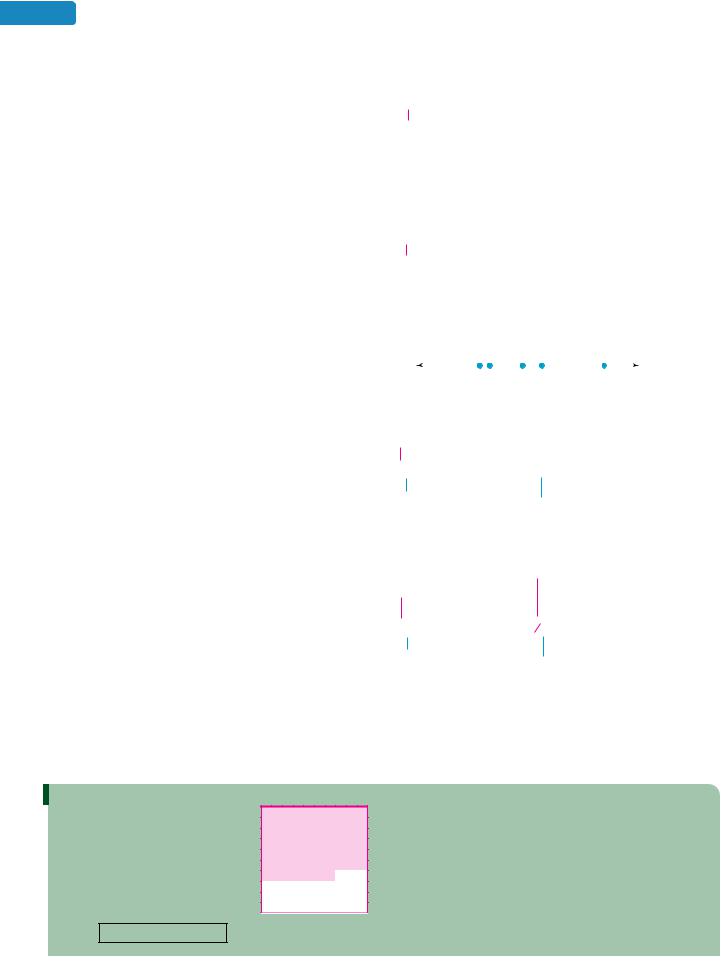
396 |
Chapter 4 |
Decimals |
|
|
|
|
|
|
|
|
|
|
|
|
|
|
|
|
|
|
|
|
|
|
|
|
|
|
|
|
|
|
|
|
|
|
|
|
|
|
|
|
|
|
|
|
|
|
|
|
|
|
|
|
|
|
|||||
|
|
|
|
|
|
|
|
|
|
|
|
|
|
|
|
|
|
|
|
|
|
|
|
|
|
|||||
|
To compare two decimals: |
Compare 47.31572 and 47.31569. |
|
|
|
|
|
|
|
|
||||||||||||||||||||
|
1. |
Make sure |
both numbers have the same |
47.315 |
7 |
2 |
|
|
|
|
|
|
|
|
|
|
|
|
|
|
|
|
|
|
|
|
||||
|
|
number of decimal places to the right of the |
|
|
|
|
|
|
|
|
|
|
|
|
|
|
|
|
|
|
|
|
||||||||
|
|
47.315 |
6 |
9 |
|
|
|
|
|
|
|
|
|
|
|
|
|
|
|
|
|
|
|
|
||||||
|
|
decimal point. Write any additional zeros |
|
|
|
|
|
|
|
|
|
|
|
|
|
|
|
|
|
|
|
|
||||||||
|
|
|
|
|
|
As we work from left to right, this is the first column in |
||||||||||||||||||||||||
|
|
necessary to achieve this. |
|
|
|
|
|
|
|
|
||||||||||||||||||||
|
|
|
|
|
|
|
|
|
|
|||||||||||||||||||||
|
2. Compare the digits of each decimal, column by |
|
|
|
|
|
|
|
|
which the digits differ. Since 7 6, it follows that |
||||||||||||||||||||
|
|
|
|
|
|
|
|
|
47.31572 is greater than 47.31569. |
|||||||||||||||||||||
|
|
column, working from left to right. |
|
|
|
|
|
|
|
|
||||||||||||||||||||
|
|
Thus, 47.31572 47.31569. |
|
|
|
|
|
|
|
|
||||||||||||||||||||
|
3. If the decimals are positive: When two digits |
|
|
|
|
|
|
|
|
|||||||||||||||||||||
|
Compare 6.418 and 6.41. |
|
|
|
|
|
|
|
|
|
|
|
|
|
|
|||||||||||||||
|
|
differ, the decimal with the greater digit is the |
|
|
|
|
|
|
|
|
|
|
|
|
|
|
||||||||||||||
|
|
|
|
|
|
|
|
|
|
|
|
|
|
|
|
|
|
|
|
|
|
|
|
|
|
|
|
|
||
|
|
greater number. |
6.41 |
8 |
|
|
|
These decimals are negative. |
|
|
|
|
|
|
|
|
||||||||||||||
|
|
|
|
|
|
|
|
|
|
|
|
|
|
|
||||||||||||||||
|
|
If the decimals are negative: When two digits |
6.41 |
0 |
|
|
|
Write a zero after 1 to help in the comparison. |
||||||||||||||||||||||
|
|
differ, the decimal with the smaller digit is the |
|
|
|
|
|
As we work from left to right, this is the first column in |
||||||||||||||||||||||
|
|
|
|
|
|
|
|
|
||||||||||||||||||||||
|
|
greater number. |
|
|
|
|
|
|
|
|||||||||||||||||||||
|
|
|
|
|
|
|
|
|
which the digits differ. Since 0 8, it follows that 6.410 |
|||||||||||||||||||||
|
|
|
|
|
|
|
|
|
|
|
||||||||||||||||||||
|
|
|
|
|
|
|
|
|
|
|
is greater than 6.418. |
|
|
|
|
|
|
|
|
|||||||||||
|
|
|
|
Thus, 6.41 6.418. |
|
|
|
|
|
|
|
|
|
|
|
|
|
|
||||||||||||
|
To graph a decimal number means to make a |
Graph 2.17, 0.6, 2.89, 3.99, and 0.5 on a number line. |
||||||||||||||||||||||||||||
|
drawing that represents the number. |
|
|
|
|
|
|
|
|
|
|
–2.89 –2.17 –0.5 0.6 |
3.99 |
|
|
|||||||||||||||
|
|
|
|
|
|
|
|
|
|
|
|
|
|
|
|
|||||||||||||||
|
|
|
|
|
|
|
|
|
|
|
|
|
|
|
|
|
|
|
|
|
|
|
|
|
|
|
|
|
||
|
|
|
|
|
|
|
|
|
|
|
−5 − 4 −3 −2 −1 0 1 2 3 4 5 |
|||||||||||||||||||
|
1. |
To round a decimal to a certain decimal place |
Round 33.41632 to the nearest thousandth. |
|||||||||||||||||||||||||||
|
|
value, locate the rounding digit in that place. |
Rounding digit: |
|
|
|
|
|
|
Keep the rounding digit: |
||||||||||||||||||||
|
2. |
Look at the test digit directly to the right of the |
|
|
|
|
|
|
||||||||||||||||||||||
|
thousandths column |
|
|
|
|
|
|
Do not add 1. |
||||||||||||||||||||||
|
|
rounding digit. |
|
|
|
|
|
|
|
|
|
|
|
|
|
|
|
|
|
|
|
|
|
|
|
|
|
|
||
|
|
|
|
|
|
|
|
|
|
|
|
|
|
|
|
|
|
|
|
|
|
|
|
|
|
|||||
|
|
33.41632 |
|
|
|
|
|
|
|
33.41632 |
|
|
|
|
|
|
|
|
||||||||||||
|
3. |
If the test digit is 5 or greater, round up by |
|
|
|
|
|
|
|
|
|
|
|
|
|
|
|
|||||||||||||
|
|
|
|
|
|
|
|
|
|
|
|
|
|
|
|
|
|
|
|
|
|
|||||||||
|
|
adding 1 to the rounding digit and dropping all |
|
|
|
|
|
|
|
|
|
|
|
|
|
|
|
|
|
|
|
|||||||||
|
|
Test digit: 3 is less than 5. |
|
|
|
|
|
|
|
|
|
Drop the test digit and all |
||||||||||||||||||
|
|
the digits to its right. If the test digit is less than |
|
|
|
|
|
|
|
|
|
|||||||||||||||||||
|
|
|
|
|
|
|
|
|
|
|
|
|
|
|
|
|
|
|
|
|
|
|
|
digits to its right. |
||||||
|
|
5, round down by keeping the rounding digit |
Thus, 33.41632 rounded to the nearest thousandth is 33.416. |
|||||||||||||||||||||||||||
|
|
and dropping all the digits to its right. |
||||||||||||||||||||||||||||
|
|
Round 2.798 to the nearest hundredth. |
|
|
|
|
|
|
|
|
||||||||||||||||||||
|
|
|
|
|
|
|
|
|
|
|
|
|||||||||||||||||||
|
|
|
|
Rounding digit: |
|
|
|
|
|
|
Add 1. Since 9 1 10, |
|||||||||||||||||||
|
|
|
|
|
|
|
|
|
|
|||||||||||||||||||||
|
|
|
|
hundredths column |
|
|
|
|
|
|
write 0 in this column and |
|||||||||||||||||||
|
|
|
|
|
|
|
|
|
|
|
|
|
|
|
|
|
1 |
|
|
|
carry 1 to the tenths column. |
|||||||||
|
|
|
|
|
|
|
|
|
|
|
|
|
|
|
|
|
|
|
|
|
|
|
|
|
|
|
||||
|
|
|
|
2.798 |
|
|
|
|
|
|
|
|
2.798 |
|
|
|
|
|
|
|
|
|
||||||||
|
|
|
|
|
|
|
|
|
|
|
|
|
|
|
|
|
|
|
|
|
|
|
|
|||||||
|
|
|
|
Test digit: 8 is 5 or greater. |
|
|
|
|
|
|
|
|
|
Drop the test digit. |
||||||||||||||||
|
|
|
|
|
|
|
|
|
|
|
|
|
||||||||||||||||||
|
|
|
|
Thus, 2.798 rounded to the nearest hundredth is 2.80. |
||||||||||||||||||||||||||
|
There are many situations in our daily lives that |
Rounded to the nearest cent, $0.14672 is $0.15. |
||||||||||||||||||||||||||||
|
call for rounding amounts of money. |
Rounded to the nearest dollar, $142.39 is $142. |
||||||||||||||||||||||||||||
|
|
|
|
|||||||||||||||||||||||||||
|
|
|
|
|
|
|
|
|
|
|
|
|
|
|
|
|
|
|
|
|
|
|
|
|
|
|
|
|
|
|
REVIEW EXERCISES
1.a. Represent the amount of the square region that is shaded, using a decimal and a fraction.
b.Shade 0.8 of the region shown below.
2.Consider the decimal number 2,809.6735.
a.What is the place value of the digit 7?
b.Which digit tells the number of thousandths?
c.Which digit tells the number of hundreds?
d.What is the place value of the digit 5?
3.Write 16.4523 in expanded notation.
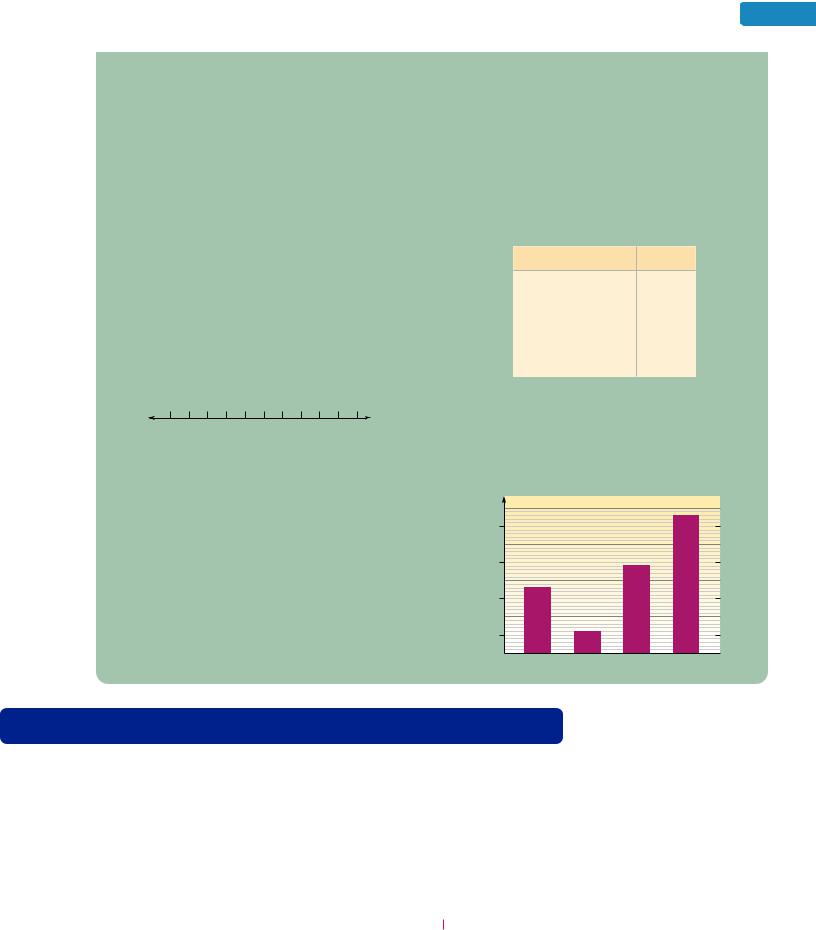
Write each decimal in words and then as a fraction or mixed number.
4.2.3
5.–615.59
6.0.0601
7.0.00001
Write each number in standard form.
8.One hundred and sixty-one hundredths
9.Eleven and nine hundred ninety-seven thousandths
10.Three hundred one and sixteen millionths
Chapter 4 Summary and Review |
397 |
23.0.2222282 nearest millionth
24.0.635265 nearest hundred-thousandth
Round each given dollar amount.
25.$0.671456 to the nearest cent
26.$12.82 to the nearest dollar
27.VALEDICTORIANS At the end of the school year, the five students listed below were in the running to be class valedictorian (the student with the highest grade point average). Rank the students in order by GPA, beginning with the valedictorian.
Place an or an symbol in the box to make a true statement.
11.5.68  5.75
5.75
12.106.8199  106.82
106.82
13.78.23  78.303
78.303
14.555.098  555.0991
555.0991
15.Graph: 1.55, 0.8, 2.1, and 2.7.
–5 –4 –3 –2 –1 0 1 2 3 4 5
16. Determine whether each statement is true or false.
a. |
78 78.0 |
b. 6.910 |
6.901 |
c. |
3.4700 3.470 |
d. 0.008 |
.00800 |
Round each decimal to the indicated place value.
17.4.578 nearest hundredth
18.3,706.0815 nearest thousandth
19.0.0614 nearest tenth
20.88.12 nearest tenth
21.6.702983 nearest ten-thousandth
22.11.314964 nearest ten-thousandth
Name GPA
Diaz, Cielo |
3.9809 |
Chou, Wendy |
3.9808 |
|
|
Washington, Shelly |
3.9865 |
|
|
Gerbac, Lance |
3.899 |
|
|
Singh, Amani |
3.9713 |
28.ALLERGY FORECAST The graph below shows a four-day forecast of pollen levels for Las Vegas, Nevada. Determine the decimal-number forecast for each day.
Allergy Alert 4-Day Forecast
for Las Vegas, Nevada
4.0 |
|
|
|
3.0 |
|
|
|
2.0 |
|
|
|
1.0 |
|
|
|
Sun. |
Mon. |
Tues. |
Wed. |
|
S E C T I O N 4.2 |
Adding and Subtracting Decimals |
||||
|
|
|
|
|
|
|
|
|
|
|
|
|
|
|
DEFINITIONS AND CONCEPTS |
EXAMPLES |
||||
|
To add or subtract decimals: |
Add: 15.82 19 32.995 |
||||
|
1. Write the numbers in vertical form with the |
Write the problem in vertical form and add, column-by-column, |
||||
|
decimal points lined up. |
|||||
|
working right to left. |
|||||
|
|
|
|
|||
|
2. Add (or subtract) as you would whole numbers. |
1 1 1 |
|
|||
|
3. Write the decimal |
point in the result from |
15.820 Insert an extra zero. |
|||
|
19.000 Insert a decimal point and extra zeros. |
|||||
|
Step 2 below the decimal points in the problem. |
|||||
|
32.995 |
|
||||
|
If the number of decimal places in the problem are |
|
||||
|
67.815 |
|
||||
|
different, insert additional zeros so that the |
|
||||
|
|
Line up the decimal points. |
||||
|
number of decimal places match. |
|
|
|||
|
|
|
||||
|
|
|
|
|||
|
|
|
|
To check the result, add bottom to top. |
||
|
|
|
|
|
|
|

398 |
Chapter 4 |
Decimals |
|
|
|
|
|
|
|
|
|
|
|
|
|
|
|
|
|
|
|
|
|
|
|
|
|
|
|
|
|
|
|||||
|
|
|
|
|
|
|
|
|
|
|
|
|
|
|||||
|
If the sum of the digits in any place-value column |
Subtract: |
8.4 3.029 |
|
|
|
|
|
||||||||||
|
is greater than 9, we must carry. |
Write the problem in vertical form and subtract, column-by-column, |
||||||||||||||||
|
|
|
|
|||||||||||||||
|
If the subtraction of the digits in any place-value |
working right to left. |
|
|
|
|
|
|||||||||||
|
column requires that we subtract a larger digit |
|
|
|
9 |
|
|
|
|
|
|
|
|
|
|
|
||
|
from a smaller digit, we must borrow or regroup. |
|
|
|
3 10 10 |
|
Insert extra zeros. |
|
|
|||||||||
|
|
|
|
|
|
8.4 0 0 |
|
|
|
|||||||||
|
|
|
|
3.0 2 9 |
|
First, borrow from the tenths column: then |
||||||||||||
|
|
|
|
|
|
5.3 7 1 |
|
borrow from the hundredths column. |
||||||||||
|
|
|
|
|
|
|
|
|
|
|
|
|
|
|
||||
|
|
|
|
To check: The sum of the difference and the subtrahend should |
||||||||||||||
|
|
|
|
equal the minuend. |
|
|
|
|
|
|
||||||||
|
|
|
|
|
|
1 1 |
|
|
|
|
|
|
|
|
|
|
|
|
|
|
|
|
|
|
5.371 |
|
|
Difference |
|
|
|
|
|
||||
|
|
|
|
|
3.029 Subtrahend |
|
|
|
|
|
||||||||
|
|
|
|
|
|
8.400 |
|
|
Minuend |
|
|
|
|
|
||||
|
To add signed decimals, we use the same rules that |
Add: |
21.35 ( 64.52) |
|
|
|
|
|
||||||||||
|
are used for adding integers. |
Find the absolute values: |
0 21.35 0 |
21.35 and 0 64.52 0 64.52 |
||||||||||||||
|
|
|
|
|||||||||||||||
|
With |
like signs: Add their absolute values and |
21.35 ( 64.52) 85.87 |
|
Add the absolute values, 21.35 |
|||||||||||||
|
attach their common sign to the sum. |
|
||||||||||||||||
|
|
|
|
|
|
|
|
|
|
|
|
|
|
and 64.52, to get 85.87. Since |
||||
|
With unlike signs: Subtract their absolute values |
|
|
|
|
|
|
|
|
|
|
|
|
|
||||
|
|
|
|
|
|
|
|
|
|
|
|
|
|
both decimals are negative, make |
||||
|
(the smaller from the larger). If the positive |
|
|
|
|
|
|
|
|
|
|
|
|
|
the final result negative. |
|||
|
decimal has the larger absolute value, the final |
Add: |
7.4 9.8 |
|
|
|
|
|
|
|
||||||||
|
answer is positive. If the negative decimal has the |
|
|
|
|
|
|
|
||||||||||
|
Find the absolute values: 0 |
7.4 0 7.4 and |
09.8 0 9.8 |
|||||||||||||||
|
larger absolute value, make the final answer |
|||||||||||||||||
|
|
|
|
|
|
|
|
|
|
|
|
|
|
|
|
|||
|
negative. |
|
|
7.4 9.8 2.4 Subtract the smaller absolute value from the |
||||||||||||||
|
|
|
|
|
||||||||||||||
|
|
|
|
|
|
|
|
|
|
|
|
|
larger: 9.8 7.4 2.4. Since the positive |
|||||
|
|
|
|
|
|
|
|
|
|
|
|
|
number, 9.8, has the larger absolute value, the |
|||||
|
|
|
|
|
|
|
|
|
|
|
|
|
final answer is positive. |
|
||||
|
To subtract two signed decimals, add the first |
Subtract: |
8.62 ( 1.4) |
|
|
|
|
|
||||||||||
|
decimal to the |
opposite of the decimal to be |
The number to be subtracted is 1.4. Subtracting 1.4 is the same |
|||||||||||||||
|
subtracted. |
|
||||||||||||||||
|
|
as adding its opposite, 1.4. |
|
|
|
|
|
|||||||||||
|
|
|
|
|
|
|
|
|
||||||||||
|
|
|
|
|
|
|
|
|
|
|
|
Add . . . |
|
|
|
|
|
|
|
|
|
|
|
|
|
|
|
|
|
|
|
|
|
|
|
|
|
|
|
|
|
8.62 ( 1.4) 8.62 1.4 7.22 |
Use the rule for |
|||||||||||||
|
|
|
|
|
|
|
|
|
|
|
|
|
|
|
|
adding two decimals |
||
|
|
|
|
|
|
|
|
|
|
|
|
|
|
|
|
|
|
|
|
|
|
|
|
|
|
|
|
|
|
|
|
. . . the opposite |
|
|
with different signs. |
||
|
Estimation can be used to check the |
Estimate the sum by rounding the addends to the nearest ten: |
||||||||||||||||
|
reasonableness of an answer to a decimal addition |
328.99 459.02 |
|
|
|
|
|
|
|
|||||||||
|
or subtraction. |
|
|
|
328.99 |
|
|
|
330 Round to the nearest ten. |
|||||||||
|
|
|
|
459.02 |
|
|
|
460 |
Round to the nearest ten. |
|||||||||
|
|
|
|
|
|
788.01 |
|
|
|
790 This is the estimate. |
||||||||
|
|
|
|
Estimate the difference by using front-end rounding: 302.47 36.9 |
||||||||||||||
|
|
|
|
Each number is rounded to its largest place value. |
||||||||||||||
|
|
|
|
|
|
302.47 |
|
|
|
300 Round to the nearest hundred. |
||||||||
|
|
|
|
36.9 |
|
|
|
|
|
40 |
Round to the nearest ten. |
|||||||
|
|
|
|
|
|
|
|
|
|
|
|
|
|
|
|
|||
|
|
|
|
|
|
265.57 |
|
|
|
260 This is the estimate. |
||||||||
|
We can use the five-step problem-solving strategy |
See Examples 10–12 that begin on page 337 to review how to solve |
||||||||||||||||
|
to solve application problems that involve decimals. |
application problems by adding and subtracting decimals. |
||||||||||||||||
|
|
|
|
|
|
|
|
|
|
|
|
|
|
|
|
|
|
|
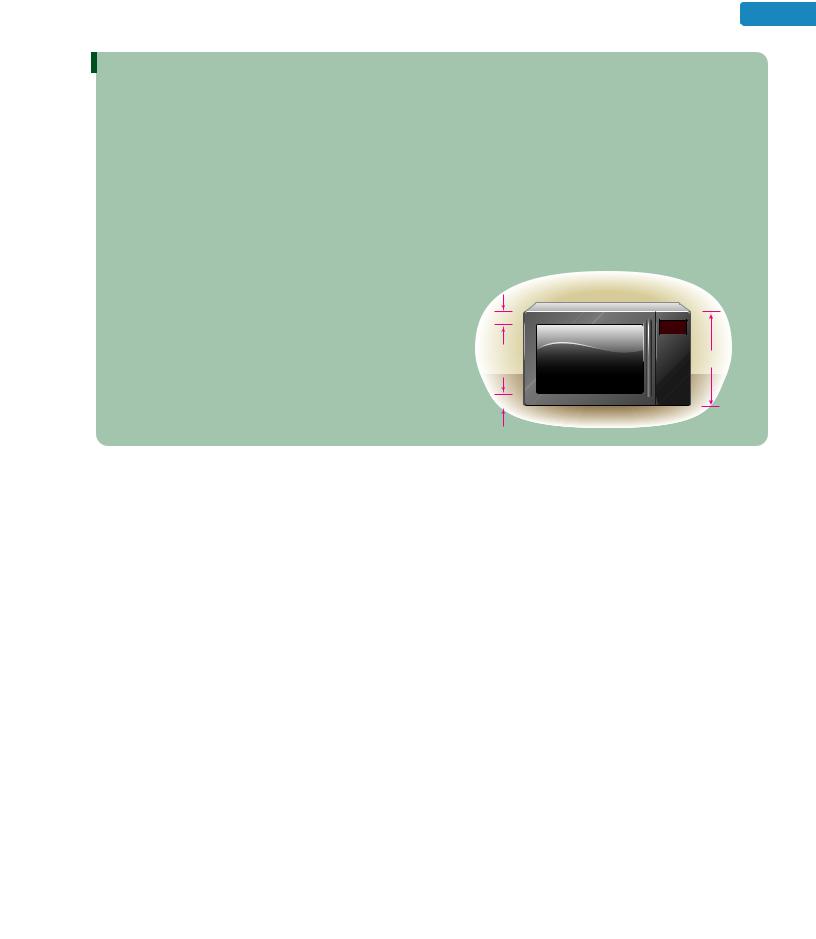
REVIEW EXERCISES
Perform each indicated operation.
29.19.5 34.4 12.8
30.3.4 6.78 35 0.008
31.68.47 53.3
32.45.8 17.372
33.9,000.09 7,067.445
34.8.61
5.97
9.72
35. |
16.1 |
8.4 |
36. |
4.8 ( 7.9) |
37. |
3.55 |
( 1.25) |
38. |
15.1 13.99 |
Evaluate each expression.
39.8.8 ( 7.3 9.5)
40.(5 0.096) ( 0.035)
41.a. Estimate the sum by rounding the addends to the nearest ten: 612.05 145.006
b.Estimate the difference by using front-end rounding: 289.43 21.86
Chapter 4 Summary and Review |
399 |
42.COINS The thicknesses of a penny, nickel, dime, quarter, half-dollar, and presidential $1 coin are
1.55millimeters, 1.95 millimeters, 1.35 millimeters,
1.75millimeters, 2.15 millimeters, and 2.00 millimeters, in that order. Find the height of a stack made from one of each type of coin.
43.SALE PRICES A calculator normally sells for $52.20. If it is being discounted $3.99, what is the sale price?
44.MICROWAVE OVENS A microwave oven is shown below. How tall is the window?
2.5 in.
|
|
2:17 |
|
|||
|
|
TIME |
CLOCK |
AUTO |
|
|
|
|
1 |
2 |
3 |
13.4 in. |
|
? |
||||||
4 |
5 |
6 |
||||
|
|
7 |
8 |
9 |
|
|
|
|
POWER |
0 |
LIGHT |
|
|
|
|
LEVEL |
|
|||
|
|
|
|
|
|
|
2.75 in.
 S E C T I O N 4.3 Multiplying Decimals
S E C T I O N 4.3 Multiplying Decimals
DEFINITIONS AND CONCEPTS
To multiply two decimals:
1.Multiply the decimals as if they were whole numbers.
2.Find the total number of decimal places in both factors.
3.Insert a decimal point in the result from step 1 so that the answer has the same number of decimal places as the total found in step 2.
When multiplying decimals, we do not need to line up the decimal points.
Multiplying a decimal by 10, 100, 1,000, and so on
To find the product of a decimal and 10, 100, 1,000, and so on, move the decimal point to the right the same number of places as there are zeros in the power of 10.
Multiplying a decimal by 0.1, 0.01, 0.001, and so on
To find the product of a decimal and 0.1, 0.01, 0.001, and so on, move the decimal point to the left the same number of places as there are in the power of 10.
EXAMPLES
Multiply: 2.76 4.3
Write the problem in vertical form and multiply 2.76 and 4.3 as if they were whole numbers.
2.76 |
2 decimal places. |
The answer will have |
||
4.3 |
1 decimal place. |
v |
||
2 1 3 decimal places. |
||||
828 |
|
|
|
|
11040 |
|
|
|
|
11.868 |
Move 3 places from right to left and insert |
|||
|
a decimal point in the answer. |
|||
|
||||
Thus, 2.76 4.3 11.868. |
|
|
||
Multiply: |
|
|
|
|
84.561 |
10,000 845,610 |
Since 10,000 has four zeros, move the |
||
|
|
|
decimal point in 84.561 four places to |
|
|
|
|
||
|
|
|
the right. Write a placeholder zero |
|
|
|
|
(shown in blue). |
|
Multiply: |
|
|
|
|
32.67 0.01 0.3267 |
Since 0.01 has two decimal places, move the |
|||
|
|
|
|
|
decimal point in 32.67 two places to the left.
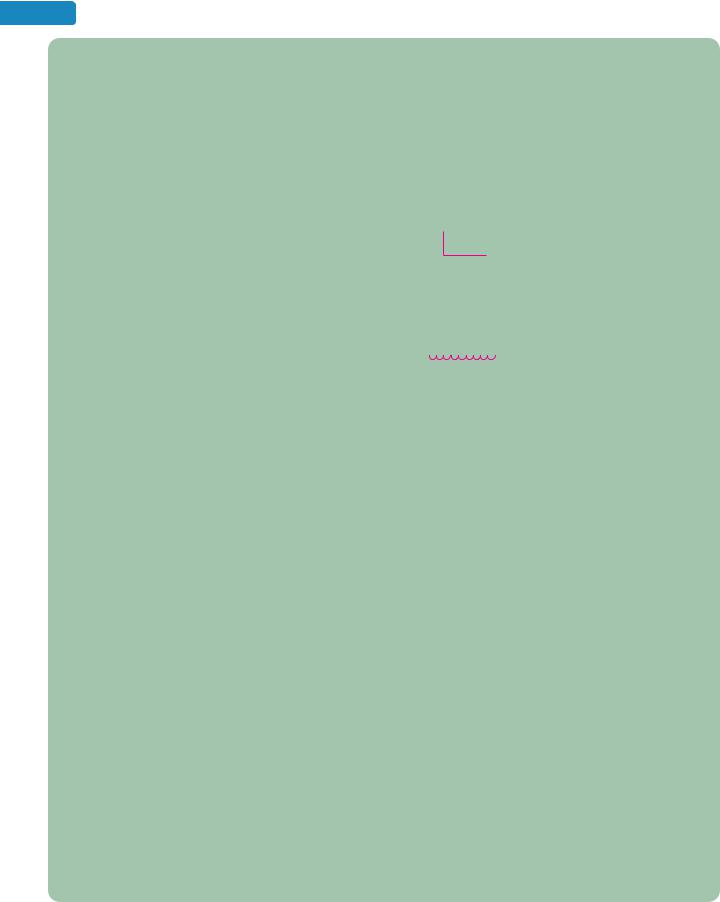
400 |
Chapter 4 Decimals |
|
|
|
|
|
|
|
|
|
|
|
|
|
|
|
|
|
|
|
|
|
The rules for multiplying integers also hold for |
Multiply: |
( 0.03)( 4.1) |
|
|
|
|
multiplying signed decimals: |
Find the absolute values: |
0 |
0.03 0 0.03 and 04.1 0 4.1 |
|
|
|
|
||||
|
|
The product of two decimals with like signs is |
Since the decimals have like signs, the product is positive. |
|||
|
|
positive, and the product of two decimals with |
||||
|
|
( 0.03)( 4.1) 0.123 |
Multiply the absolute values, |
|||
|
|
unlike signs is negative. |
||||
|
|
|
|
|
|
0.03 and 4.1, to get 0.123. |
|
|
|
Multiply: |
5.7(0.4) |
|
|
|
|
|
Find the absolute values: |
0 |
5.7 0 5.7 and 00.4 0 0.4 |
|
|
|
|
Since the decimals have unlike signs, the product is negative. |
|||
We can use the rule for multiplying a decimal by a |
Write 4.16 billion in standard notation: |
|||||||
power of ten to write large numbers in standard |
4.16 billion 4.16 |
1 billion |
|
|||||
form. |
|
|||||||
|
4.16 1,000,000,000 Write 1 billion in standard form. |
|||||||
|
|
|||||||
|
|
4,160,000,000 |
Since 1,000,000,000 has nine |
|||||
|
|
|
|
|
|
|
zeros, move the decimal point in |
|
|
|
|
|
|
|
|
||
|
|
|
|
|
|
|
4.16 nine places to the right. |
|
|
|
|
|
|
|
|
||
The base of an exponential expression can be a |
Evaluate: |
(1.5)2 |
|
|
|
|||
positive or a negative decimal. |
(1.5)2 1.5 1.5 |
|
The base is 1.5 and the exponent is 2. Write the base |
|||||
|
|
|
|
|
as a factor 2 times. |
|||
|
2.25 |
|
|
Multiply the decimals. |
||||
|
Evaluate: ( 0.02)2 |
|
|
|||||
|
( 0.02)2 ( 0.02)( 0.02) |
The base is 0.02 and the exponent is 2. |
||||||
|
|
|
|
|
|
|
Write the base as a factor 2 times. |
|
|
0.0004 |
|
|
Multiply the decimals. The product of two |
||||
|
|
|
|
|
|
|
decimals with like signs is positive. |
|
|
|
|
||||||
To evaluate a formula, we replace the letters with |
Evaluate P 2l 2w for l 4.9 and w 3.4. |
|||||||
specific numbers and then use the order of |
P 2l 2w |
|
|
|
|
|||
operations rule. |
|
|
|
|
||||
2(4.9) 2(3.4) |
Replace l with 4.9 and w with 3.4. |
|||||||
|
||||||||
|
9.8 6.8 |
|
Do the multiplication. |
|||||
|
16.6 |
|
|
|
Do the addition. |
|||
|
|
|
||||||
Estimation can be used to check the reasonableness |
Estimate 37 8.49 by front-end rounding. |
|||||||
of an answer to a decimal multiplication. |
37 |
|
|
|
40 Round to the nearest ten. |
|||
|
|
|
||||||
|
|
|
|
|||||
|
8.49 |
|
|
8 |
Round to the nearest one. |
|||
|
|
|
||||||
320 This is the estimate.
The estimate is 320. If we calculate 37 8.49, the product is exactly 314.13.
We can use the five-step problem-solving strategy to See Examples 12 and 13 that begin on page 351 to review how to solve application problems that involve decimals. solve application problems by multiplying decimals.

REVIEW EXERCISES
Multiply. |
|
|
|
45. |
2.3 6.9 |
46. |
32.45(6.1) |
47. |
1.7 |
48. |
275 |
0.004 |
8.4 |
||
49. |
15.5( 9.8) |
50. |
( 0.003)( 0.02) |
51. |
1,000(90.1452) |
52. |
0.001(2.897) |
Evaluate each expression. |
|
|
|
53. |
(0.2)2 |
54. |
( 0.15)2 |
55.(0.6 0.7)2 ( 3)( 4.1)
56.3(7.8) 2(1.1)2
57.( 3.3)2(0.00001)
58.(0.1)3 2 0 45.63 12.24 0
59.Write each number in standard notation.
a.GEOGRAPHY China is the third largest country in land area with territory that extends over 9.6 million square kilometers. (Source: china.org)
b.PLANTING TREES In 2008, the Chinese people planted 2.31 billion trees in mountains, city parks, and along highways to increase the number of forests in their country. (Source: xinhuanet.com)
60.a. Estimate the product using front-end rounding: 193.28 7.63
b.Estimate the product by rounding the factors to the nearest tenth: 12.42 7.38
Chapter 4 Summary and Review |
401 |
61.Evaluate the formula A P Prt for P 70.05, r 0.08, and t 5.
62.SHOPPING If crab meat sells for $12.95 per pound, what would 1.5 pounds of crab meat cost? Round to the nearest cent.
63.AUTO PAINTING A manufacturer uses a threepart process to finish the exterior of the cars it produces.
Step 1: A 0.03-inch-thick rust-prevention undercoat is applied.
Step 2: Three layers of color coat, each 0.015 inch thick, are sprayed on.
Step 3: The finish is then buffed down, losing 0.005 inch of its thickness.
What is the resulting thickness of the automobile’s finish?
64.WORD PROCESSORS The Page Setup screen for a word processor is shown. Find the area that can be filled with text on an 8.5 in. 11 in. piece of paper if the margins are set as shown.
Page Setup
Margins
Margins Preview
Top |
1.0 in. |
|
Bottom |
0.6 in. |
|
Left |
0.5 in. |
|
Right |
0.7 in. |
|
Help |
Ok |
Cancel |
 S E C T I O N 4.4 Dividing Decimals
S E C T I O N 4.4 Dividing Decimals
DEFINITIONS AND CONCEPTS
To divide a decimal by a whole number:
1.Write the problem in long division form and place a decimal point in the quotient (answer) directly above the decimal point in the dividend.
2.Divide as if working with whole numbers.
3.If necessary, additional zeros can be written to the right of the last digit of the dividend to continue the division.
EXAMPLES
Divide: 6.2 4
1.55
4 6.20
4
2 2
2 0
20
20
0
Place a decimal point in the quotient that lines up with the decimal point in the dividend.
Ignore the decimal points and divide as if working with whole numbers.
Write a zero to the right of the 2 and bring it down. Continue to divide.
The remainder is 0.
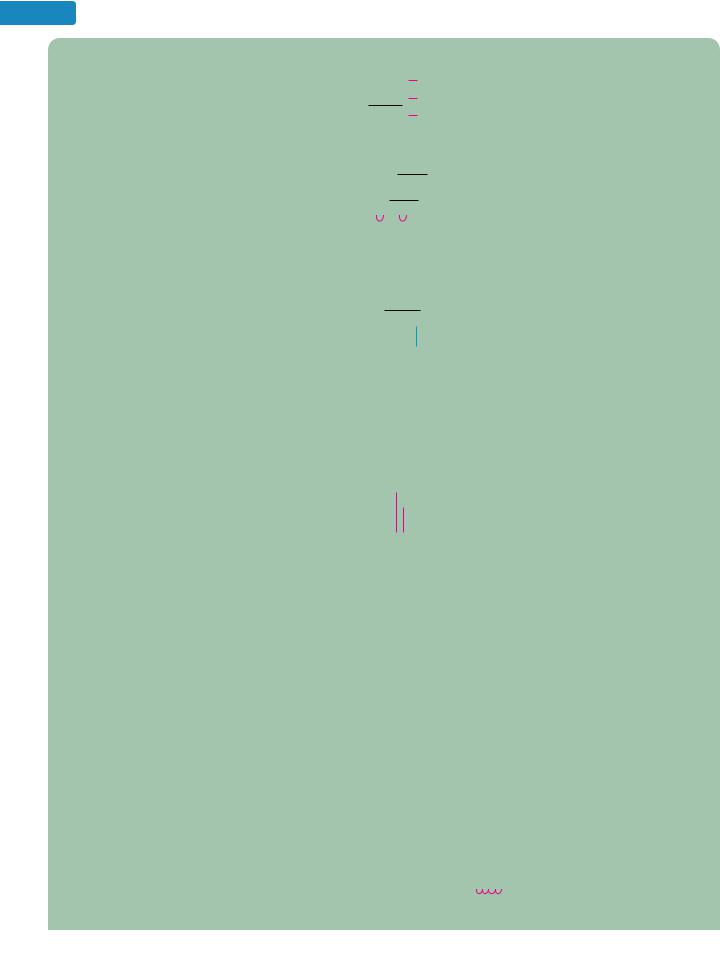
402 |
Chapter 4 Decimals |
|
|
|
|
|
|
|
To check the result, we multiply the divisor by the quotient. The result should be the dividend.
To divide with a decimal divisor:
1.Write the problem in long division form.
2.Move the decimal point of the divisor so that it becomes a whole number.
3.Move the decimal point of the dividend the same number of places to the right.
4.Write a decimal point in the quotient (answer) directly above the decimal point in the dividend. Divide as if working with whole numbers.
5.If necessary, additional zeros can be written to the right of the last digit of the dividend to continue the division.
Sometimes when we divide decimals, the subtractions never give a zero remainder, and the division process continues forever. In such cases, we can round the result.
To estimate quotients, we use a method that approximates both the dividend and the divisor so that they divide easily. There is one rule of thumb for this method: If possible, round both numbers up or both numbers down.
Dividing a decimal by 10, 100, 1,000, and so on
To find the quotient of a decimal and 10, 100, 1,000, and so on, move the decimal point to the left the same number of places as there are zeros in the power of 10.
Check:
1.55Quotient
4 Divisor
6.20Dividend
The check confirms that 6.2 4 1.55.
Divide: |
1.462 |
|
3.4 |
||
|
||
3.4 1.462 Write the problem in long division form. Move the decimal |
||
|
|
|
point of the divisor, 3.4, one place to the right to make it a whole number. Move the decimal point of the dividend, 1.462, the same number of places to the right.
Now use the rule for dividing a decimal by a whole number.
0.4 3
34 14.6 213 6
1 0 21 0 2 0
Write a decimal point in the quotient (answer) directly above the decimal point in the dividend.
Divide as with whole numbers.
Divide: 0.77 6. Round the quotient to the nearest hundredth.
To round to the hundredths column, we need to continue the division process for one more decimal place, which is the thousandths column.
|
|
|
|
|
|
|
Rounding digit: hundredths column |
||||||
|
|
|
|
|
|
|
|||||||
|
|
|
|
|
|
|
Test digit: Since 8 is 5 or greater, add 1 |
||||||
|
|
|
|
|
|
|
|||||||
|
|
|
|
|
|
|
to the rounding digit and drop the test digit. |
||||||
|
|
|
|
|
|
|
|
|
|||||
0.128 |
|
|
|
|
|
|
|
|
|||||
6 |
|
|
|
|
|
|
|
|
|
|
|
|
|
0.770 |
|
|
|
|
|
|
|
||||||
6 |
|
|
|
|
|
|
|
|
|
|
|
||
17 |
|
|
|
|
|
|
|
|
|
||||
12 |
|
|
|
|
|
|
|
|
|
||||
50 |
|
|
|
|
|
|
|
|
|||||
48 |
|
|
|
|
|
|
|
|
|||||
2 |
The remainder is still not 0. |
||||||||||||
Thus, 0.77 6 0.13. |
|
|
|
|
|||||||||
Estimate the quotient: 337.96 23.8 |
|||||||||||||
|
|
|
|
|
|
|
|
|
|
||||
|
|
|
|
|
The dividend is |
|
|
|
|
||||
|
|
|
|
|
|
|
|
|
|||||
|
|
|
|
|
approximately |
|
|
|
|
||||
|
|
|
|
|
|
|
|
|
|
|
|
|
|
337.96 23.8 |
320 20 16 To divide, drop one zero from |
||||||||||||
|
|
|
|
|
|
|
|
|
|
|
|||
|
|
|
|
|
|
|
|
|
|
|
|
|
320 and one zero from 20, |
|
|
|
|
|
|
|
|
|
The divisor is |
|
|||
|
|
|
|
|
|
|
|
|
|
and then find 32 2. |
|||
|
|
|
|
|
|
|
|
|
approximately |
|
|||
|
|
|
|
|
|
|
|
|
|
|
|||
|
|
|
|||||||||||
The estimate is 16. (The exact answer is 14.2.) |
|||||||||||||
Divide: 79.36 10,000
79.36 10,000 0.007936 Since the divisor 10,000 has four zeros, move the decimal point four
places to the left. Insert two placeholder zeros (shown in blue).
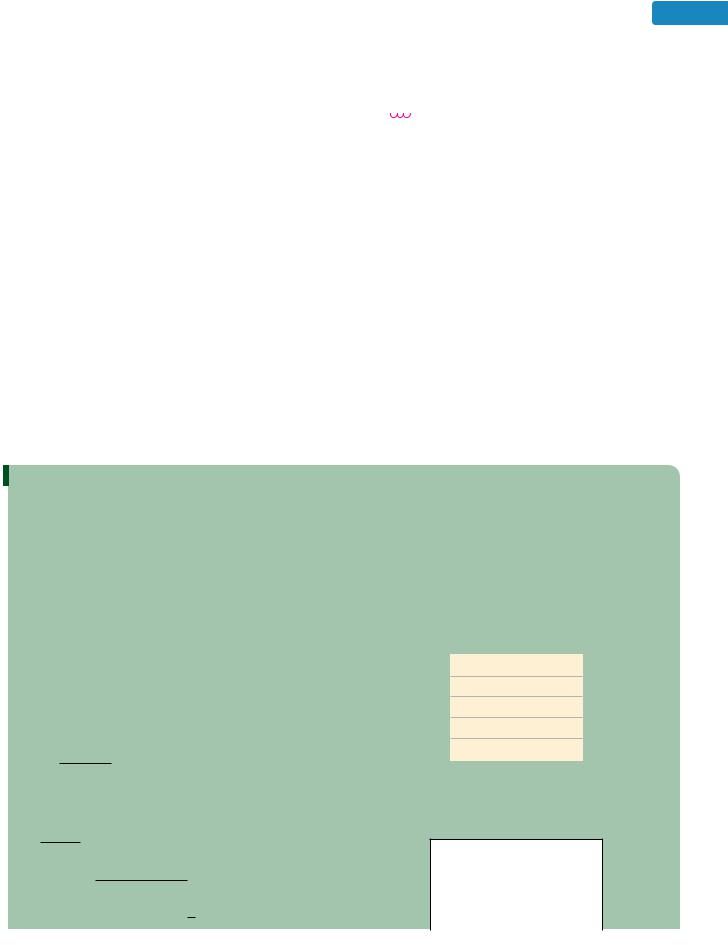
403
|
|
|
|
|
|
|
|
|
|
|
|
|
|
|
|
|
|
Dividing a decimal by 0.1, 0.01, 0.001, and so on |
|
Divide: |
1.6402 |
|
|
|
|
|
|
|
|
||||||
To find the quotient of a decimal and 0.1, 0.01, |
|
0.001 |
|
|
|
|
|
|
|
|
|
||||||
|
|
|
|
|
|
|
|
|
|
|
|
||||||
|
|
|
|
|
|
|
|
|
|
|
|
|
|
|
|
|
|
0.001, and so on, move the decimal point to the |
|
|
1.6402 |
1,640.2 |
|
Since the divisor 0.001 has three decimal places, |
|||||||||||
right the same number of decimal places as there |
|
|
|
||||||||||||||
0.001 |
|
||||||||||||||||
|
|
|
|
|
|
|
|
move the decimal point in 1.6402 three places to |
|||||||||
are in the power of 10. |
|
|
|
|
|
|
|
|
|||||||||
|
|
|
|
|
|
|
|
|
|
|
|
||||||
|
|
|
|
|
|
|
|
|
|
|
|
the right. |
|||||
|
|
|
|
|
|
|
|
|
|
|
|
|
|||||
The rules for dividing integers also hold for |
|
Divide: |
|
1.53 |
|
|
0.3 |
|
|
|
|||||||
|
|
|
|
|
|
|
5.1 Since the signs of the dividend and divisor |
||||||||||
dividing signed decimals. The quotient of two |
|
|
|
|
|
|
|
|
|
|
|
|
|
|
|
|
are unlike, the final answer is negative. |
|
|
|
|
|
|
|
|
|
|
|
|
|
|
|
|
||
decimals with like signs is positive, and the |
|
|
|
0.84 |
|
|
|
|
|
|
|
|
|
||||
quotient of two decimals with unlike signs is |
|
Divide: |
|
0.2 |
|
|
Since the dividend and divisor have like signs, |
||||||||||
|
4.2 |
|
|
|
|||||||||||||
negative. |
|
|
|
|
|
|
|
|
|
|
|
|
|
the quotient is positive. |
|||
We use the order of operations rule to evaluate |
|
Evaluate: |
|
|
|
37.8 (1.2)2 |
|
|
|
|
|||||||
expressions and formulas. |
|
|
|
0.1 0.3 |
|
|
|
|
|
||||||||
|
|
|
|
|
|
|
|
|
|
||||||||
|
|
37.8 (1.2)2 |
|
|
37.8 1.44 In the numerator, evaluate (1.2)2. |
||||||||||||
|
|
0.1 0.3 |
|
|
|
|
0.4 |
|
|
|
In the denominator, do the addition. |
||||||
|
|
|
|
|
|
|
|
|
|||||||||
|
|
|
|
|
|
|
|
36.36 |
|
|
|
|
In the numerator, do the subtraction. |
||||
|
|
|
|
|
|
|
0.4 |
|
|
|
|
||||||
|
|
|
|
|
|
90.9 |
|
|
|
|
Do the division indicated by the fraction |
||||||
|
|
|
|
|
|
|
|
|
|
|
|
|
|
|
|
bar. |
|
We can use the five-step problem-solving strategy to |
|
See Examples 10 and 11 that begin on page 366 to review how to |
|||||||||||||||
solve application problems that involve decimals. |
|
solve application problems by dividing decimals. |
|||||||||||||||
|
|
|
|
|
|
|
|
|
|
|
|
|
|
|
|
|
|
REVIEW EXERCISES
Divide. Check the result. |
|
|
|
|
|||||
65. |
|
|
|
|
|
66. |
41.8 4 |
|
|
3 27.9 |
|
|
|
||||||
67. |
29.67 |
|
68. |
24.618 0.6 |
|||||
23 |
|
|
|||||||
|
|
|
|
|
|
|
|||
69. |
80.625 12.9 |
70. |
0.0742 |
|
|
||||
|
|
|
|||||||
1.4 |
|
|
|||||||
|
|
|
|
|
|
|
|
|
|
71. |
15.75 |
|
|
|
72. |
0.003726 |
|
||
|
|
|
|
|
|
|
|||
0.25 |
|
|
|
0.0046 |
|
||||
73. |
89.76 1,000 |
74. |
0.0112 |
|
|
||||
10 |
|
|
|||||||
|
|
|
|
|
|
|
|
|
|
75.Divide 0.8765 by 0.001.
76.77.021 0.0001
Estimate each quotient:
77.4,983.01 41.33
78.8.8 25,904.39
Divide and round each result to the specified decimal place.
79.78.98 6.1 (nearest tenth)
80.5.438 (nearest hundredth) 0.007
(1.4)2 2( 4.6)
81.Evaluate:
0.50.3
82.Evaluate the formula C 59 (F 32) for F 68.9.
83.THANKSGIVING DINNER The cost of purchasing the food for a Thanksgiving dinner for a family of 5 was $41.70. What was the cost of the dinner per person?
84.DRINKING WATER Water samples from five wells were taken and tested for PCBs (polychlorinated biphenyls). The number of parts per billion (ppb) found in each sample is given below. Find the average number of parts per billion for these samples.
Sample #1: 0.44 ppb
Sample #2: 0.50 ppb
Sample #3: 0.46 ppb
Sample #4: 0.52 ppb
Sample #5: 0.63 ppb
85.SERVING SIZE The illustration below shows the package labeling on a box of children’s cereal. Use the information given to find the number of servings.
Nutrition Facts
Serving size |
1.1 ounce |
Servings per container |
? |
Package weight |
15.4 ounces |
|
|
|
|
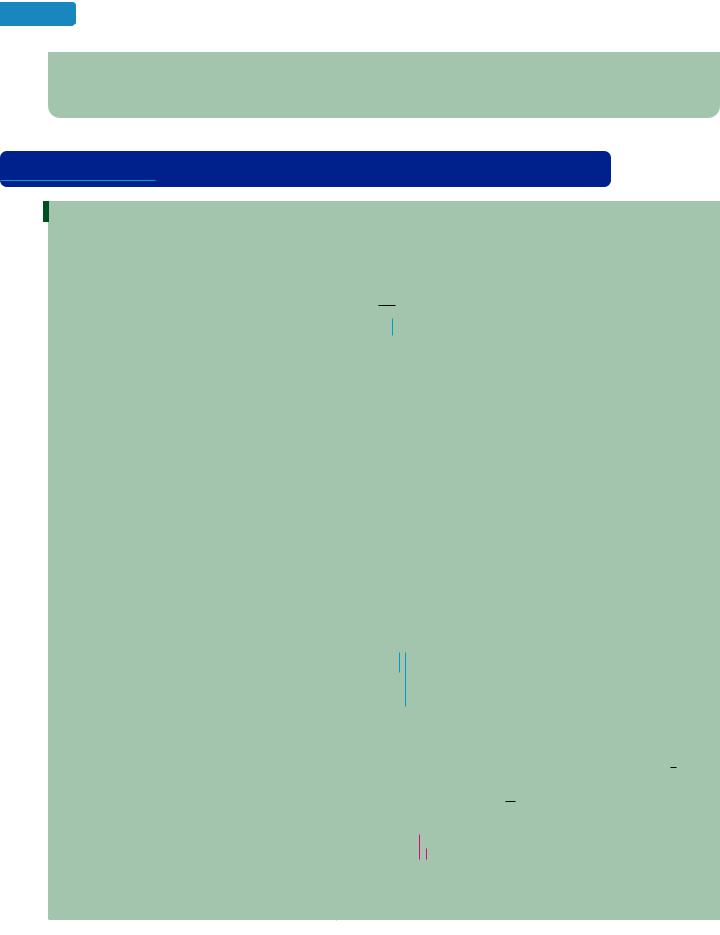
404 |
Chapter 4 Decimals |
86.TELESCOPES To change the position of a focusing mirror on a telescope, an adjustment knob is used. The mirror moves 0.025 inch with each revolution of the knob. The mirror needs to be
moved 0.2375 inch to improve the sharpness of the image. How many revolutions of the adjustment knob does this require?
 S E C T I O N 4.5 Fractions and Decimals
S E C T I O N 4.5 Fractions and Decimals
DEFINITIONS AND CONCEPTS
A fraction and a decimal are said to be equivalent if they name the same number.
To write a fraction as a decimal, divide the numerator of the fraction by its denominator.
Sometimes, when finding the decimal equivalent of a fraction, the division process ends because a remainder of 0 is obtained. We call the resulting decimal a terminating decimal.
If the denominator of a fraction in simplified form has factors of only 2’s or 5’s, or a combination of both, it can be written as a decimal by multiplying it by a form of 1. The objective is to write the fraction in an equivalent form with a denominator that is a power of 10, such as 10, 100, 1,000, and so on.
Sometimes, when we are finding the decimal equivalent of a fraction, the division process never gives a remainder of 0. We call the resulting decimal a repeating decimal.
An overbar can be used instead of the three dots
. . . to represent the repeating pattern in a repeating decimal.
When a fraction is written in decimal form, the result is either a terminating or repeating decimal. Repeating decimals are often rounded to a specified place value.
EXAMPLES
Write 35 as a decimal.
We divide the numerator by the denominator because a fraction bar indicates division: 35 means 3 5.
0.6
5 3.0
|
|
|
|
|
|
|
30 |
|
|
|
|
||
|
|
0 |
|
|
Since a zero remainder is obtained, the |
|
|
|
|
|
|
||
|
|
|
|
|
result is a terminating decimal. |
|
Thus, |
3 |
0.6. We say that 0.6 is the decimal equivalent of |
3. |
|||
|
5 |
|
|
|
|
5 |
Write |
3 |
as a decimal. |
|
|||
25 |
|
|||||
|
|
|
|
|
|
|
Since we need to multiply the denominator of |
3 |
|
by 4 to obtain a |
|||||||||||||||||
25 |
||||||||||||||||||||
denominator of 100, it follows that 4 should be |
|
|||||||||||||||||||
|
|
|
||||||||||||||||||
|
|
|
|
|
|
|
|
|
|
|
4 |
|
|
|
|
|||||
the form of 1 that is used to build |
3 |
. |
|
|
|
|
||||||||||||||
|
|
|
|
|
||||||||||||||||
|
|
|
|
|
|
|
|
|
|
|
25 |
|
|
|
|
|||||
|
3 |
|
|
3 |
|
|
4 |
Multiply |
3 |
by 1 in the form of |
4. |
|
|
|
||||||
25 |
|
|
|
4 |
|
|
|
|
||||||||||||
25 |
|
|
|
25 |
|
|
4 |
|
|
|
||||||||||
|
|
|
|
12 |
|
|
Multiply the numerators. |
|
|
|
|
|||||||||
|
|
|
|
|
|
|
|
|
Multiply the denominators. |
|
|
|
|
|||||||
|
|
|
100 |
|
|
|
|
|
|
|||||||||||
|
|
|
0.12 |
|
Write the fraction as a decimal. |
|
|
|
||||||||||||
Write |
5 as a decimal. |
|
|
|
|
|||||||||||||||
|
|
|
6 |
|
|
|
|
|
|
|
|
|
|
|
|
|
|
|
|
|
0.833 |
|
|
|
|
|
|
|
|
|
|
|
|
|
|
||||||
6 |
|
|
|
|
|
|
|
|
|
|
|
|
||||||||
5.000 |
|
|
|
|
|
Write a decimal point and three |
|
|
|
|
||||||||||
4 8 |
|
|
|
|
|
|
additional zeros to the right of 5. |
|
|
|
|
|||||||||
|
|
|
|
|
|
|
|
|
|
|
|
|
|
|
|
|
|
|
||
|
|
|
20 |
|
|
|
|
|
|
|
|
|
|
|
|
|
|
|
||
18 |
|
|
|
|
|
It is apparent that 2 will continue to reappear as the |
||||||||||||||
|
|
|
|
|
|
|
|
|
||||||||||||
|
|
|
|
|
|
|
|
|
|
|
|
|
|
|
|
|
|
|||
|
|
|
20 |
|
|
|
|
|
remainder. Therefore, 3 will continue to reappear in the |
|||||||||||
|
|
|
18 |
|
|
|
|
|
||||||||||||
|
|
|
|
|
|
|
|
quotient. Since the repeating pattern is now clear, we can |
||||||||||||
|
|
|
2 |
|
|
|
|
|||||||||||||
|
|
|
|
|
|
stop the division. |
|
|
|
|
||||||||||
Thus, 56 0.8333 . . . , or, using an overbar, we have 56 0.83.
The decimal equivalent for 115 is 0.454545 . . . . Round it to the nearest hundredth.
|
|
|
|
|
|
|
Rounding digit: hundredths column. |
|
|
|
|
|
|
|
|
||
5 |
|
|
|
|
|
Test digit: Since 4 is less than 5, round down. |
||
|
||||||||
|
||||||||
|
|
|
||||||
|
|
0.454545 . . . |
||||||
11 |
||||||||
Thus, |
5 |
0.45. |
|
|||||
11 |
||||||||
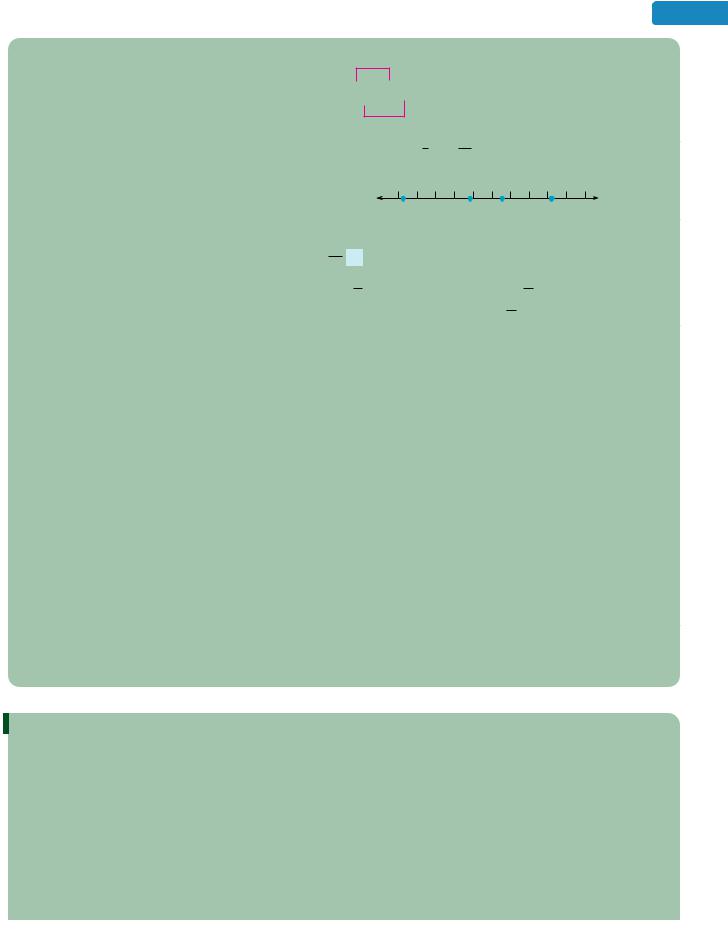
Chapter 4 Summary and Review |
405 |
|
|
|
|
|
|
|
To write a mixed number in decimal form, we need only find the decimal equivalent for the fractional part of the mixed number.The whole-number part in the decimal form is the same as the wholenumber part in the mixed-number form.
A number line can be used to show the relationship between fractions and decimals.
To compare the size of a fraction and a decimal, it is helpful to write the fraction in its equivalent decimal form.
To evaluate expressions that can contain both fractions and decimals, we can work in terms of decimals or in terms of fractions.
We can use the five-step problem-solving strategy to solve application problems that involve fractions and decimals.
Whole-number part
4 7 |
|
4.875 |
|
|
|
|
|
|
|
b |
|
8 |
|||
Write the fraction as a decimal.
Graph 3.125, 457, 0.6, 1.09 on a number line.
|
5 |
|
|
|
|
|
|
–4 |
– |
|
|
|
|
|
|
–1.09 |
0.6 |
3.125 |
|||||
|
7 |
||||||
−5 − 4 −3 −2 −1 0 1 2 3 4 5
Place an , , or an symbol in the box to make a true statement:
3
50
0.07
To write 503 as a decimal, divide 50 by 3: 503 0.06.
Since 0.06 is less than 0.07, we have: 503 0.07.
Evaluate: |
1 |
0.31 |
|
|
|
|
|
|
|
|
|
|
|
||||||
|
|
|
6 |
|
|
|
|
|
|
|
|
|
|
|
|
|
|
|
|
If we work in terms of fractions, we have: |
|||||||||||||||||||
|
1 |
0.31 |
|
1 |
|
|
31 |
|
|
|
|
|
Write 0.31 in fraction form. |
||||||
|
6 |
6 |
100 |
|
|
|
|
|
|||||||||||
|
|
|
|
|
1 |
50 |
|
31 |
|
3 |
The LCD is 300. Build each fraction |
||||||||
|
|
|
|
|
|
|
|
|
|
|
|
|
|
by multiplying by a form of 1. |
|||||
|
|
|
|
6 |
50 |
|
100 |
3 |
|||||||||||
|
|
|
|
|
50 |
|
|
|
|
93 |
|
|
|
Multiply the numerators. |
|||||
|
|
|
|
300 |
|
300 |
|
|
|
Multiply the denominators. |
|||||||||
|
|
|
|
|
143 |
|
|
|
|
|
|
|
|
|
|
|
Add the numerators and write the |
||
|
|
|
|
300 |
|
|
|
|
|
|
|
|
|
|
|
sum over the common denominator |
|||
|
|
|
|
|
|
|
|
|
|
|
|
|
|
|
|
|
|
|
300. |
If we work in terms of decimals, we have:
1 |
0.31 0.17 |
0.31 |
Approximate |
1 |
with the decimal 0.17. |
|
6 |
6 |
|||||
|
|
|
|
|||
|
0.48 |
|
Do the addition. |
|||
See Example 13 on page 381 to review how to solve application problems involving fractions and decimals.
REVIEW EXERCISES
Write each fraction or mixed number as a decimal. Use an |
Write each fraction as a decimal. Round to the nearest |
||||||||||||||||||||||||||
overbar when necessary. |
|
|
|
|
|
|
|
hundredth. |
|
|
|
|
|
|
|
|
|
||||||||||
87. |
7 |
|
|
|
88. |
2 |
|
|
95. |
19 |
|
|
|
|
|
96. |
31 |
|
|
|
|
|
|
||||
|
|
|
|
|
|
|
|
|
|
|
|
|
|
|
|
|
|
|
|
|
|
||||||
8 |
|
|
|
5 |
|
|
33 |
|
|
|
|
|
30 |
|
|
|
|
|
|
||||||||
89. |
9 |
|
|
90. |
3 |
|
|
|
|
|
Place an , , or an symbol in the box to make a true |
||||||||||||||||
16 |
|
|
50 |
|
|
|
|
statement. |
|
|
|
|
|
|
|
|
|
||||||||||
|
6 |
|
|
|
|
|
4 |
|
|
13 |
|
|
|
|
|
|
4 |
|
|
|
|
|
|||||
91. |
|
|
|
92. |
|
|
|
|
97. |
|
|
|
0.499 |
98. |
|
|
|
|
|
0.26 |
|||||||
11 |
|
|
3 |
|
|
|
|||||||||||||||||||||
|
|
|
25 |
|
15 |
|
|
||||||||||||||||||||
|
|
|
|
|
|
|
|
|
|
|
|
|
|
|
|
|
|||||||||||
|
7 |
|
|
26 |
|
|
|
|
99. |
Write the numbers in order from smallest to largest: |
|||||||||||||||||
93. |
3 |
|
|
|
94. |
|
|
|
|
|
|
|
3310 , |
|
|
|
|
|
|
|
|
|
|
|
|
|
|
125 |
|
45 |
|
|
|
|
|
0.3, |
0.3 |
|
|
|
|
|
|
|
|
|
|||||||||
|
|
|
|
|
|
|
|
|
|
|
|
|
|
|
|
|
|
|
|
|
|
||||||

406 |
Chapter 4 Decimals |
100. Graph 1.125, 3.3, 234 , and 109 on a number line.
−5 −4 −3 −2 −1 0 1 2 3 4 5
Evaluate each expression. Work in terms of fractions.
1 |
0.4 |
5 |
0.19 |
||
101. |
|
102. |
|
||
3 |
6 |
||||
Evaluate each expression. Work in terms of decimals.
103. |
4 |
( 7.8) |
104. |
1 |
a7.3 |
5 |
9 |
b |
|
||
5 |
8 |
10 |
|
||||||||
105. |
1 |
(9.7 8.9)(10) |
106. |
7.5 |
(0.78)a |
1 |
b |
2 |
|||
2 |
2 |
|
|||||||||
107.ROADSIDE EMERGENCY What is the area of the reflector shown below?
10.9 in.

 6.4 in.
6.4 in. 

108.SEAFOOD A shopper purchased 34 pound of crab meat, priced at $13.80 per pound, and 13 pound of lobster meat, selling for $35.70 per pound. Find the
total cost of these items.
 S E C T I O N 4.6 Square Roots
S E C T I O N 4.6 Square Roots
DEFINITIONS AND CONCEPTS
The square root of a given number is a number whose square is the given number.
Every positive number1 has two square roots. The number 0 has only one square root.
as 14, find the positive square root of the radicand.
A radical symbol is used to indicate a positive
square root. To evaluate a radical expression such
Radical symbol
|
|
|
|
|
|
14 |
|
|
Radicand Read as “the |
||
|
|
||||
|
|
||||
b |
|
|
|
||
Radical expression |
square root of 4.” |
|
Numbers such as 4, 64, and 225, that are squares of whole numbers, are called perfect squares. To evaluate square1root radical expressions, it is helpful to be able to identify perfect square radicands.
Review the list of perfect squares on page 00.
The symbol is used to indicate the negative square root of a positive number. It is the opposite of the positive square root.
We can find the square root of fractions and decimals.
EXAMPLES
Find the two square roots of 81.
9 is a square root of 81 because 92 81 and
91is a square root of 81 because ( 9)2 81.
Evaluate each square root:
1 4 2
1 64 8
225 15
Evaluate: |
1 |
|
|
|
|
|
|
|
|
|
|
|||||
36 |
|
|
|
|
|
|
|
|
|
|||||||
1 |
|
|
is the opposite (or negative) of the square root of 36. Since |
|||||||||||||
36 |
||||||||||||||||
136 6, we have: |
|
|
|
|
|
|
||||||||||
1 |
|
|
6 |
|
|
|
|
|
|
|
|
|
||||
36 |
|
|
|
|
|
|
||||||||||
Evaluate each square root: |
|
|
|
|
|
|
||||||||||
1 |
|
|
|
|
|
|
|
|
|
|
|
|
|
|
||
49 |
|
Ask: What positive fraction, when squared, is |
49 |
? |
||||||||||||
|
|
|
|
|||||||||||||
|
B100 |
|||||||||||||||
|
100 |
|||||||||||||||
|
The answer is |
7 |
because 1 |
7 |
22 |
49 |
. |
|
|
|||||||
|
10 |
10 |
100 |
|||||||||||||
0.25Ask: What positive decimal, when squared, is 0.25? The answer is 0.5 because (0.5)2 0.25.

|
|
|
|
|
|
|
|
|
|
|
|
|
|
|
|
|
|
|
|
|
Chapter 4 |
Summary and Review |
407 |
|||
|
|
|
|
|
|
|
|
|
|
|
|
|
|
|
|
|
|
|
|
|
|
|
|
|
|
|
|
When evaluating an expression containing square |
|
|
|
20 6123 41 |
|
2 |
|
|
|
|
|
||||||||||||||
|
Evaluate: |
9 |
|
|
|
|
||||||||||||||||||||
|
roots, evaluate square roots at the same stage in |
Perform the operations within the parentheses first. |
|
|
||||||||||||||||||||||
|
your solution as exponential expressions. |
|
|
|||||||||||||||||||||||
|
20 6123 41 |
|
|
2 20 6(8 4 3) |
|
Within the parentheses, |
|
|
||||||||||||||||||
|
|
|
|
|
|
9 |
|
|
|
|||||||||||||||||
|
|
|
|
|
|
|
|
|
|
|
|
|
|
|
|
|
|
|
|
|
|
|
|
evaluate the exponential |
|
|
|
|
|
|
|
|
|
|
|
|
|
|
|
|
|
|
|
|
|
|
|
|
|
|
expression and the square |
|
|
|
|
|
|
|
|
|
|
|
|
|
|
|
|
|
|
|
|
|
|
|
|
|
|
root. |
|
|
|
|
|
|
|
|
|
|
|
20 6(8 12) |
|
|
Within the parentheses, do |
|
|
||||||||||||
|
|
|
|
|
|
|
|
|
|
|
|
|
|
|
|
|
|
|
|
|
|
|
|
the multiplication. |
|
|
|
|
|
|
|
|
|
|
|
20 6( 4) |
|
|
Within the parentheses, do |
|
|
||||||||||||
|
|
|
|
|
|
|
|
|
|
|
|
|
|
|
|
|
|
|
|
|
|
|
|
the subtraction. |
|
|
|
|
|
|
|
|
|
|
|
20 ( 24) |
|
|
Do the multiplication. |
|
|
||||||||||||
|
|
|
|
|
|
|
|
|
4 |
|
|
|
|
Do the addition. |
|
|
||||||||||
|
|
|
|
|
|
Evaluate a 2 |
|
|
|
|
|
|
|
|
|
|
|
|
|
|||||||
|
To evaluate formulas that involve square roots, we |
c2 b2 |
for c 25 and b 20. |
|
|
|||||||||||||||||||||
|
replace the letters with specific numbers and then |
|
|
|
|
|
|
|
|
|
|
|
|
|
|
|
|
|
|
|
|
|
||||
|
a 2c2 b2 |
This is the formula to evaluate. |
|
|
||||||||||||||||||||||
|
use the order of operations rule. |
|
|
|||||||||||||||||||||||
|
|
|
|
252 202 |
|
Replace c with 25 and b with 20. |
|
|
||||||||||||||||||
|
|
|
|
|
|
|
|
|
|
|||||||||||||||||
|
|
|
|
|
|
1 |
|
|
|
|
|
|
|
Evaluate the exponential expressions. |
|
|
||||||||||
|
|
|
|
|
|
625 400 |
|
|
|
|||||||||||||||||
|
|
|
|
|
|
|
|
225 |
|
|
|
|
|
|
|
|
Do the subtraction. |
|
|
|||||||
|
|
|
|
|
|
15 |
|
|
|
|
|
|
|
|
|
|
Evaluate the square root. |
|
|
|||||||
|
If a number is not a perfect square, we can use the |
Approximate 1 |
|
|
|
|
|
Round to the nearest hundredth. |
|
|
||||||||||||||||
|
149. |
|
|
|||||||||||||||||||||||
|
square root key |
|
1 |
|
on a calculator (or a table of |
From a scientific calculator we get 1 |
|
12.20655562. Rounded |
|
|
||||||||||||||||
|
|
|
|
|
|
|||||||||||||||||||||
|
|
149 |
|
|
||||||||||||||||||||||
|
square roots) to find its approximate square root. |
|
|
|||||||||||||||||||||||
|
to the nearest hundredth, |
|
|
|
|
|||||||||||||||||||||
|
|
|
|
|
|
1 |
|
12.21 |
|
|
|
|
|
|
|
|
|
|
|
|||||||
|
|
|
|
|
|
149 |
|
|
|
|
|
|
|
|
|
|
|
|||||||||
|
|
|
|
|
|
|
|
|
|
|
|
|
|
|
|
|
|
|
|
|
|
|
|
|
|
|
REVIEW EXERCISES
109. |
Find the two square roots of 25. |
|
|
|
|
|
||||||||||||||||||||
110. |
Fill in the blanks: 1 |
|
|
|
because |
|
2 49. |
|||||||||||||||||||
49 |
|
|
|
|
||||||||||||||||||||||
Evaluate each square root without using a calculator. |
||||||||||||||||||||||||||
111. |
1 |
|
|
|
|
112. |
1 |
|
|
|
|
|
|
|||||||||||||
49 |
|
|
16 |
|
|
|
|
|
||||||||||||||||||
113. |
1 |
|
|
|
|
114. |
1 |
|
|
|
|
|
|
|
|
|||||||||||
100 |
|
0.09 |
|
|
|
|
|
|||||||||||||||||||
|
|
|
|
|
|
|
|
|
|
|
|
|
|
|
|
|
|
|
|
|
|
|
|
|||
|
64 |
|
|
|
|
|
|
|
|
|
|
|
|
|
|
|
|
|
|
|
||||||
115. |
B |
|
|
|
|
116. |
10.81 |
|
|
|
|
|
||||||||||||||
169 |
|
|
|
|
|
|||||||||||||||||||||
|
|
|
|
|
|
|
|
|
|
|
|
|
|
|
10 |
|
|
|
|
|
|
|
|
|
||
|
1 |
|
|
|
|
|
|
|
|
|
|
|
|
|
|
|
||||||||||
117. |
B |
|
|
|
|
1 |
8. |
|
|
|
|
|
|
|
|
|
||||||||||
36 |
|
|
|
|
|
|
|
|
||||||||||||||||||
119. |
Graph each square root: |
1 |
9, 1 |
|
|
|
1 |
3, 1 |
|
|||||||||||||||||
2, |
|
16 |
||||||||||||||||||||||||
(Hint: Use a calculator or square root table to approximate any square roots, when necessary.)
−5 −4 −3 −2 −1 0 1 2 3 4 5
120. Use a calculator to approximate each square root
to the nearest hundredth. |
c. 112.75 |
||
a. |
119 |
b. 1598 |
|
Evaluate each expression without using a calculator. |
|||||||||||||||||||||
121. |
31 |
|
|
|
|
|
122. |
51 |
|
|
|
|
|||||||||
100 |
|
|
|
196 |
|
|
|
||||||||||||||
|
|
|
|
|
|
|
|
|
|
|
|
|
|
|
100 |
|
|
|
|
||
123. |
3149 136 |
|
|
124. |
B |
|
|
1225 |
|||||||||||||
|
9 |
||||||||||||||||||||
125. |
40 6[52 (7 2) |
1 |
|
D |
|
|
|
|
|
|
|
|
|||||||||
16 |
|
|
|
|
|
|
|
|
|||||||||||||
126. |
1 7[62 (1 2)1 |
|
|
D |
|
|
|
|
|
|
|
|
|||||||||
81 |
|
|
|
|
|
|
|
|
|||||||||||||
|
Evaluate b 2 |
|
|
|
|
|
for c 17 and a 15. |
||||||||||||||
127. |
c2 a2 |
||||||||||||||||||||
128. |
SHEET METAL Find the length of the side of the |
||||||||||||||||||||
|
range hood shown in the illustration below. |
||||||||||||||||||||
129.Between1 what two whole numbers would 183 be located when graphed on a number line?
130.7 2.646. Explain why an symbol is used and not an symbol.1,089 in.
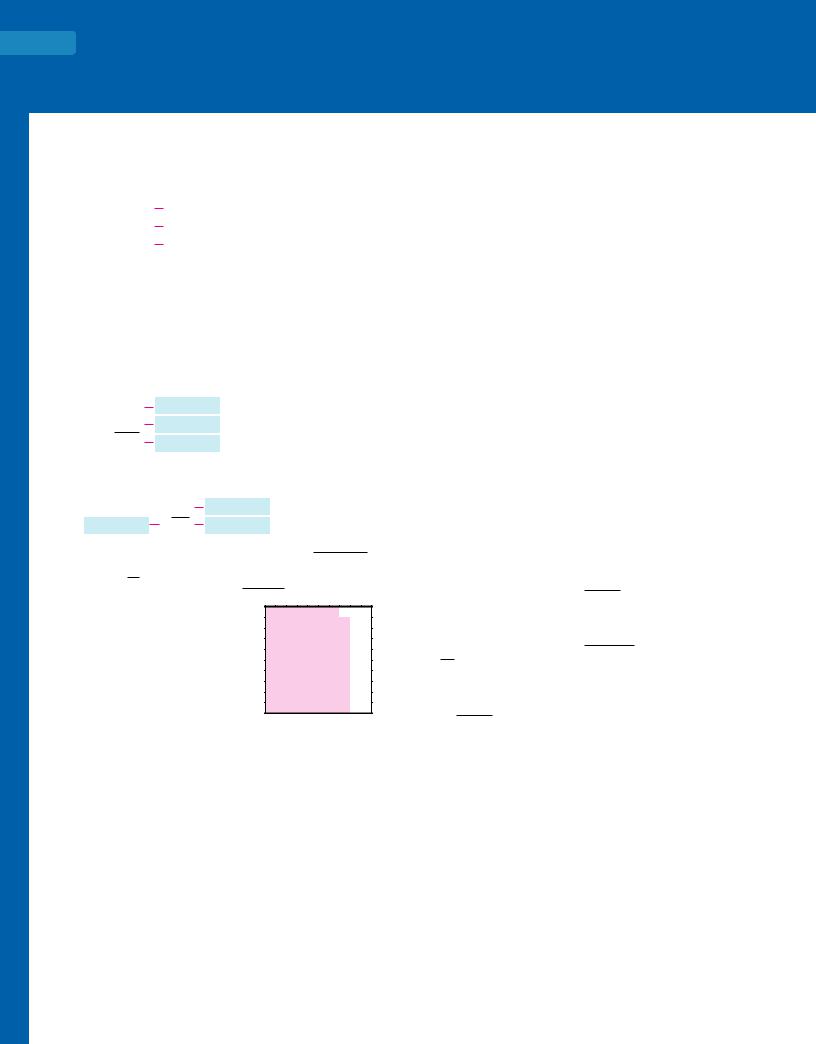
408
C H A P T E R 4 TEST
1.Fill in the blanks.
a.Copy the following addition. Label each addend and the sum.
2.67
6.01 
8.68
b.Copy the following subtraction. Label the minuend, the subtrahend, and the difference.
9.6 |
|
|
|
|
6.2 |
|
|
|
|
|
|
|
||
|
|
|
||
3.4 |
|
|
|
|
|
|
|
||
|
|
|
||
|
|
|
|
|
5.Write four thousand five hundred nineteen and twentyseven ten-thousandths in standard form.
6.Write each decimal in
•expanded form
•words
•as a fraction or mixed number. (You do not have to simplify the fraction.)
a.SKATEBOARDING Gary Hardwick of Carlsbad, California, set the skateboard speed record of 62.55 mph in 1998. (Source: skateboardballbearings.com)
c.Copy the following multiplication. Label the factors and the product.
b. MONEY A dime weighs 0.08013 ounce.
|
1.3 |
|
|
|
7. |
Round each decimal number to the indicated |
||||
|
|
|
|
|
place value. |
|
|
|||
|
|
7 |
|
|
|
|
|
|
||
|
|
|
|
|
|
461.728, nearest tenth |
|
|||
|
9.1 |
|
|
|
|
a. |
|
|||
|
|
|
|
|
|
|
|
|
||
d. Copy the following division. Label the dividend, |
|
b. |
2,733.0495, nearest thousandth |
|||||||
|
c. 1.9833732, nearest millionth |
|||||||||
|
the divisor, and the quotient. |
|
|
|||||||
|
|
|
|
|
|
|
||||
|
|
|
3.4 |
|
|
8. Round $0.648209 to the nearest cent. |
||||
|
|
|
|
|
|
|
|
|
||
|
|
|
|
|
|
|
|
|
|
|
|
|
|
2 6.8 |
|
|
Perform each operation. |
|
|
||
e. 0.6666 . . . and 0.8333 . . . are examples of |
9. |
4.56 2 0.896 3.3 |
|
|
||||||
|
Subtract 39.079 from 45.2 |
|
||||||||
|
decimals. |
|
|
|
10. |
|
||||
f. |
The 1 |
|
symbol is called a |
symbol. |
11. |
(0.32)2 |
12. |
0.1368 |
||
|
0.24 |
|||||||||
2. Express the amount of the square |
|
|
|
|
|
|||||
|
13. |
6.7( 2.1) |
14. |
8.7 |
||||||
region that is shaded using a |
|
|||||||||
|
|
|
|
|
0.004 |
|||||
fraction and a decimal. |
|
|
|
|
|
|||||
|
|
|
|
|
|
|||||
|
|
|
|
|
|
15. |
11 13 |
16. |
2.4 ( 1.6) |
|
|
|
|
|
|
|
17. Divide. Round the quotient to the nearest hundredth: |
||||
|
|
|
|
|
|
|
|
12.146 |
|
|
3.Consider the decimal number: 629.471
a.What is the place value of the digit 1?
b.Which digit tells the number of tenths?
c.Which digit tells the number of hundreds?
d.What is the place value of the digit 2?
4. WATER PURITY |
|
Pollution, |
|
A county health |
City |
parts per million |
|
department |
|
|
|
Monroe |
0.0909 |
||
sampled the |
|||
Covington |
0.0899 |
||
pollution content of |
|||
tap water in five |
Paston |
0.0901 |
|
cities, with the |
Cadia |
0.0890 |
|
|
|||
results shown. Rank |
Selway |
0.1001 |
|
the cities in order, |
|||
|
|
||
from dirtiest tap water to cleanest. |
|
||
5.3
18.a. Estimate the product using front-end rounding: 34 6.83
b.Estimate the quotient: 3,907.2 19.3
19.Perform each operation in your head.
a.567.909 1,000
b.0.00458 100
20.Write 61.4 billion in standard notation.
21.EARTHQUAKE DAMAGE After an earthquake, geologists found that the ground on the west side of the fault line had dropped 0.834 inch. The next week,
astrong aftershock caused the same area to sink 0.192 inch deeper. How far did the ground on the west side of the fault drop because of the earthquake and the aftershock?
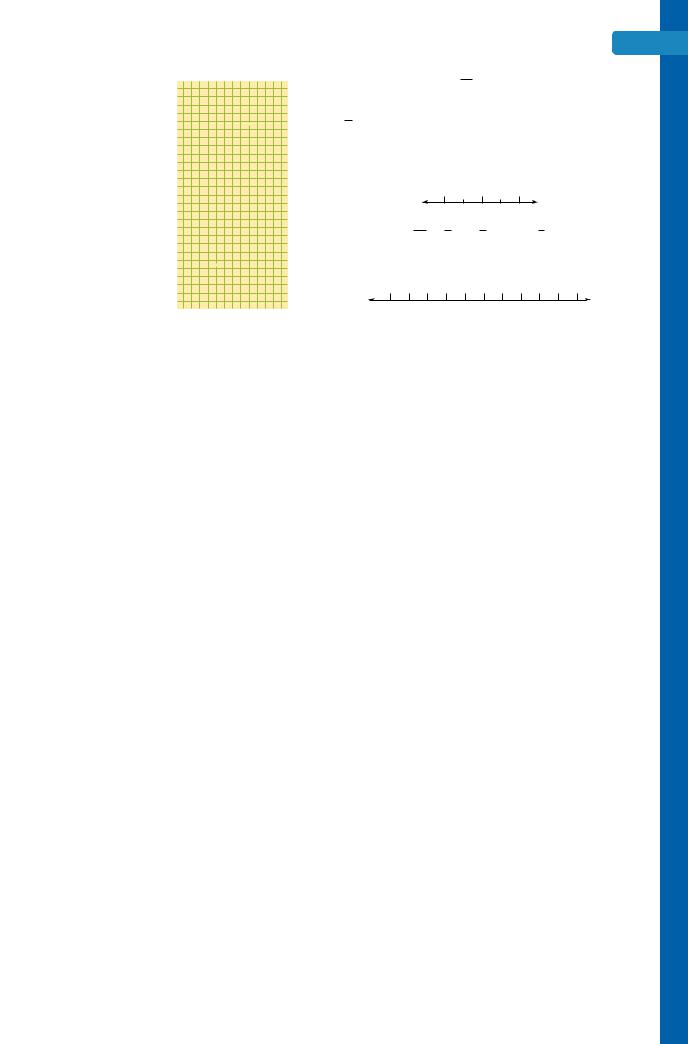
|
|
|
|
|
|
|
|
Chapter 4 |
Test |
409 |
22. |
NEW YORK CITY Refer to |
Central Park North |
31. |
8 2124 60 61812 |
|
|
|
|||
|
the illustration on the right. |
|
|
|
2 |
|
|
|
|
|
|
Central Park, which lies in the |
|
|
|
|
|
|
|
|
|
|
|
|
32. |
3 0.7 (Work in terms of fractions.) |
|
|
||||
|
middle of Manhattan, is the |
|
|
|
|
|||||
|
|
|
|
|
|
|
|
|
|
|
|
city’s best-known park. If it is |
West |
|
33. |
a. |
Graph 83 , 32 , and 54 on a number line. Label each |
|
|||
|
2.5 miles long and 0.5 mile |
|
|
|
point using the decimal equivalent of the fraction. |
|||||
|
wide, what is its area? |
Park |
|
|
|
|
|
|
|
|
|
|
|
|
|
|
|
|
|
|
|
23. |
TELEPHONE BOOKS |
Central |
|
|
|
−1 |
0 |
1 |
|
|
|
To print a telephone book, |
|
Ave. |
|
b. |
Graph 116, 12, |
19, and 15 on a number |
|
||
|
565 sheets of paper were used. |
|
Fifth |
|
|
line. (Hint: When necessary, use a calculator or |
|
|||
|
|
|
|
|
|
|||||
|
If the book is 2.26 inches thick, |
|
|
|
|
|
||||
|
|
|
|
|
square root table to approximate a square root.) |
|
||||
|
what is the thickness of each |
|
|
|
|
|
||||
|
|
|
|
|
|
|
|
|
|
|
|
sheet of paper? |
Central Park South |
|
|
|
|
|
|
|
|
|
|
|
|
−5 − 4 −3 −2 −1 0 1 2 3 4 5 |
|
|||||
|
|
|
|
|
|
|
||||
24.ACCOUNTING At an ice-skating complex, receipts on Friday were $130.25 for indoor skating and $162.25 for outdoor skating. On Saturday, the corresponding amounts were $140.50 and $175.75. On which day, Friday or Saturday, were the receipts higher? How much higher?
25.CHEMISTRY In a lab experiment, a chemist mixed three compounds together to form a mixture weighing 4.37 g. Later, she discovered that she had forgotten to record the weight of compound C in her notes. Find the weight of compound C used in the experiment.
|
Weight |
|
|
Compound A |
1.86 g |
Compound B |
2.09 g |
Compound C |
? |
Mixture total |
4.37 g |
|
|
26.WEIGHT OF WATER One gallon of water weighs 8.33 pounds. How much does the water in a 212-gallon jug weigh?
27.Evaluate the formula C 2pr for p 3.14 and r 1.7.
28.Write each fraction as a decimal.
17 |
5 |
||
a. |
|
b. |
|
50 |
12 |
||
Evaluate each expression.
29.4.1 (3.2)(0.4)2
30.a25b2 6 ` 6.2 3 14 `
34. SALADS A shopper purchased 34 pound of potato
salad, priced at $5.60 per pound, and 1 pound of
coleslaw, selling for $4.35 per pound. Find the total cost of these items.
2 3
35. Use a calculator to evaluate c a2 b2 for a 12 and b 35.
a.1 b. 2 169
37.Fill in the blank: 144  because
because  2 144.
2 144.
38.Place an , , or an symbol in the box to make a true statement.
a.6.78  6.7936. Write each number in decimal form.2725
6.7936. Write each number in decimal form.2725
|
b. |
0.3 |
|
|
|
|
3 |
|
|
|
|
|
|
|
|
|
|||||||
|
|
|
|
|
|
|
|
|
|
|
|
|
|
||||||||||
|
|
|
|
|
8 |
|
|
|
|
|
|
|
|
|
|||||||||
|
|
|
|
|
|
|
|
|
|
|
|
|
|
|
|
|
|
|
|
|
|||
|
|
|
|
|
|
|
|
|
|
|
|
|
|
|
|
|
|
|
|
|
|
|
|
|
|
|
|
B |
16 |
|
|
|
|
|
|
|
|
|
|
|
|
|
|
||||
|
c. |
|
|
|
|
|
|
0.4 |
|
|
|
||||||||||||
|
|
|
|
|
|
|
|
|
|
|
|
||||||||||||
|
81 |
|
|
|
|
|
|
|
|
|
|||||||||||||
|
|
|
|
|
|
|
|
|
|
|
|
|
|
|
|
|
|
||||||
|
|
0.45 |
|
|
|
|
|
|
|
|
|
|
|
||||||||||
|
d. |
|
|
|
|
0.45 |
|
|
|||||||||||||||
Evaluate each expression without using a calculator. |
|||||||||||||||||||||||
39. |
2 |
1 |
|
|
|
3 |
1 |
|
|
|
|
||||||||||||
25 |
49 |
||||||||||||||||||||||
|
|
|
|
|
|
|
|
|
|
|
|
|
|
|
|
|
|
|
|
|
|
|
|
|
|
|
|
1 |
|
|
|
|
|
|
|
1 |
|
|
|
|
|
|
|
||||
40. |
B |
|
|
|
B |
|
|
|
|
|
|
|
|
|
|
||||||||
36 |
25 |
|
|||||||||||||||||||||
41. |
Evaluate each square root without using a calculator. |
||||||||||||||||||||||
|
a. |
1 |
|
|
|
|
|
|
|
|
|
|
|
|
|
|
|
||||||
|
0.04 |
|
|
|
|
|
|
|
|
||||||||||||||
|
b. |
1 |
|
|
|
|
|
|
|
|
|
|
|
|
|
|
|
|
|||||
|
.69 |
|
|
|
|
|
|
|
|
|
|
|
|
||||||||||
|
c. |
1225 |
|
|
|
|
|
|
|
|
|
|
|
|
|
||||||||
|
d. |
1 |
|
|
|
|
|
|
|
|
|
|
|
|
|
|
|
||||||
|
121 |
|
|
|
|
|
|
|
|
|
|
||||||||||||
42. |
Although the decimal 3.2999 contains more digits |
||||||||||||||||||||||
|
than 3.3, it is smaller than 3.3. Explain why this is so. |
||||||||||||||||||||||
